

Climate Change & Epidemics 2024 Report
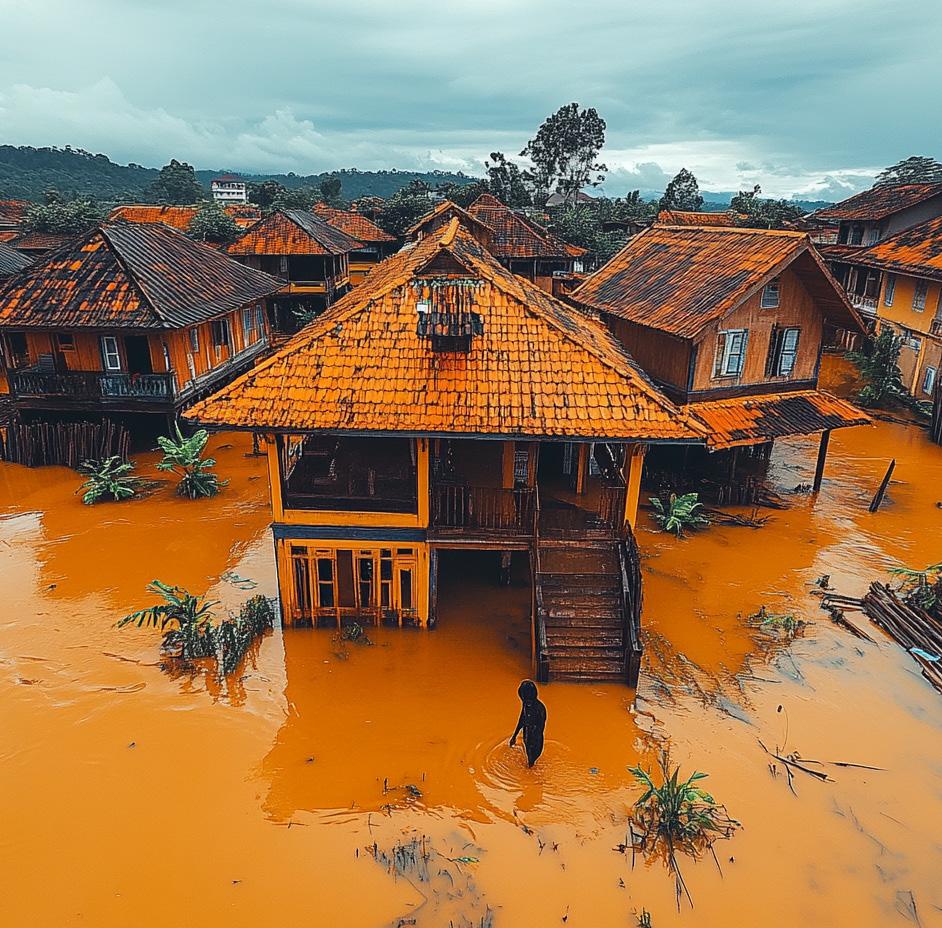
CLIMATE CHANGE & EPIDEMICS 2024
CLIMADE Consortium Report
Summary for Policymakers COP29
Edited by
The Core Writing Team
Tulio de Oliveira
CLIMADE Consortium Director
Centre for Epidemic Response and Innovation (CERI), Stellenbosch University, South Africa
Cheryl Baxter
Head Scientific Support Centre for Epidemic Response and Innovation (CERI), Stellenbosch University, South Africa
Writing Team:
Luiz Carlos Junior Alcantara (FioCruz, Brazil), Houriiyah Tegally (CERI, South Africa), Maambele Khosa (CERI, South Africa), Monika Moir (CERI, South Africa), Marta Giovanetti (FioCruz, Brazil), Vagner Fonseca (Pan American Health Organization (PAHO), Brazil), José Lourenço (Universidade Católica Portuguesa, Portugal), Edward Holmes (University of Sydney, Australia), Samuel Oyola (International Livestock Research Institute (ILRI), Kenya), Moritz Kraemer (Oxford University, U.K.), Joseph L.-H. Tsui (Oxford University, U.K.), Richard Lessells (University of KwaZulu-Natal (UKZN), South Africa)
Technical Support for the CLIMADE Consortium Report
Maambele Khosa (CERI, Stellenbosch University, South Africa)
Referencing this report:
CLIMADE Consortium. Summary for Policymakers: COP29. In: Climate Change and Epidemics 2024. CLIMADE Consortium report. [Core writing team, T. de Oliveira and C. Baxter (eds)]. CLIMADE, Stellenbosch, South Africa. pp1-32 https://climade.health/climade-cop29-report/
Contributing authors from CLIMADE Consortium:
Ambroise Ahouidi (Institut de Recherche en Santé, de Surveillance Épidémiologique et de Formations (IRESSEF), Senegal), Abdou Padane (IRESSEF, Senegal), Abdualmoniem Omer Abdalla Musa (General Administration of Laboratories and Blood Banks, Ministry of Health, Kassala state, Sudan), Adugna Abera (Ethiopian Public Health Institute, Ethiopia), Alex Ansaye Mwanyongo (Public Health Institute of Malawi), Allan Campbell (Central Public Health Reference Laboratory, Sierra Leone), Aloysious Ssemaganda (National Health Laboratories and Diagnostic Services - Central Public Health Laboratories, Uganda), Argentina Felisbela Muianga (Instituto Nacional de Saude, Mozambique), Aziza John Samson (Tanzania), Bernard Onoja (University of Ibadan, Nigeria), Birhanu Desta Alemu (PATH, Ethiopia), Chantal Akoua-Koffi (CHU de Bouaké / Université Alassane Ouattara, Côte d'Ivoire), Darren Martin (University of Cape Town, South Africa), Mohamed Zahir Alimohamed (Muhimbili University of Health and Allied Sciences, Tanzania), Fredy Brice Nemg Simo (Centre for Research in Infectious Disease, Cameroon), Girma Godebo(Wachemo University, Ethiopia), Giacomo Maria Paganotti (Botswana-University of Pennsylvania Partnership), James Ayei Maror (National Public Health Laboratory, South Sudan), John Oludele (Instituto Nacional de Saude, Mozambique), Joseph Fokam (Chantal BIYA International Reference Centre, Cameroon), Kenneth K Maeka (National Microbiology Reference Laboratory, Ministry of Health, Zimbabwe), Lavanya Singh (KwaZulu Research Innovation Sequencing Platform (KRISP), UKZN, South Africa), Martin Faye (Institut Pasteur de Dakar, Senegal), Michael Owusu (Kwame Nkrumah University of Science and Technology, Ghana), Michel Ngonga Dikongo (Biologiste, Gabon), Molalegne Bitew (Bio and Emerging Technology Institute, Ethiopia), Nkuurunziza Jerome (Hope Africa University, National Institute of Public Health Reference Laboratory, Burundi), Nokuzola Mbhele (University of Cape Town, South Africa), Oyewale Tomori (ACEGID-RUN, Nigeria), Ramuth Magalutcheemee (Ministry of Health, Mauritius), Sara Abdelrahman Abuelmaali (National Public Health Laboratory, Sudan), Wolfgang Preiser (University of Stellenbosch / National Health Laboratory Service, Tygerberg, South Africa)
CLIMADE CONSORTIUM, 2024
© CLIMADE Consortium, 2024
The designations employed and the presentation of material on maps do not imply the expression of any opinion whatsoever on the part of the institutions of the authors or funders, the legal status of any country, territory, city or area or of its authorities, or concerning the delimitation of its frontiers or boundaries. The mention of specific companies or products does not imply that they are endorsed or recommended by CLIMADE in preference to others of a similar nature, which are not mentioned or advertised.
Short extracts from this publication may be reproduced without authorization provided that the complete source is clearly indicated.
Editorial correspondence and requests to publish, reproduce or translate articles in part or in whole should be addressed to: CLIMADE Secretariat, Centre for Epidemic Response and Innovation (CERI), Level 3, Biomedical Research Institute (BMRI) Building, Tygerberg Medical School Campus, Stellenbosch University, Address: Francie Van Zijl Dr, Tygerberg, Cape Town, 7505 Tel.: +27 82 962 4219 E-mail: ceri@sun.ac.za, website: https://climade.health
The following abbreviations have been used:
BMRI Biomedical Research Institute
CERI Centre for Epidemic Response and Innovation
CFR Case Fatality rate
CLIMADE Climate Amplified Diseases and Epidemics
ENSO El Nino Southern Oscillation
FIOCRUZ Fundação Oswaldo Cruz
IDMC Internal Displacement Monitoring Centre
ILRI International Livestock Research Institute
IRESSEF Institut de Recherche en Santé, de Surveillance Épidémiologique et de Formations
KRISP KwaZulu Research Innovation Sequencing Platform
PAHO Pan American Health Organization
SARS-CoV-2 severe acute respiratory syndrome coronavirus 2
UKZN University of KwaZulu-Natal
WNV West Nile Virus
List of Figures
Figure 1: Two medical workers transfer a patient from the cholera treatment unit of Médecins Sans Frontières to the intensive care unit at the general hospital in Masisi, in the east of the Democratic Republic of the Congo 8
Figure 2: a) Absolute change in climate suitability on the Index P scale between 1979–1983 (past) to 2018–2022 (present). b–d Estimated trend in climate suitability for dengue virus transmission per pixel using monthly Index P time series from 1979 to 2022 for Africa, South America and South Asia/South-East Asia. Pixels with trends that are not significant at a false discovery rate (FDR) < 0.10 are white. 13
Figure 3: Proportion of samples with a WHO validated/candidate kelch13 mutations over time. The black dashed line highlights 2006 - the year in which the WHO recommended Artemisinin based (ACT) therapy as a first-line treatment measure in Africa (WHO, 2006). Notably, the rapid increase in prevalence of WHO kelch13 markers in East and Northeast African countries is similar to that observed in Southeast Asian countries between 2007 and 2016.
Figure 4: Distribution of confirmed dengue cases in Pakistan by province, 1 January to 22 September 2022
13
15
Figure 5: Distribution of internally displaced persons (IDPs) by country and hazard, comparison with outward migrations and country-wise net migration against its vulnerability 18
Figure 6: Trend per continent of the proportion of disease burden and the GDP per capita of countries. Measured in disability-adjusted life years (DALY) from infectious diseases alongside GDP per capita in US$ for each respective country. Dot size represents the population size of the country 18
Figure 7: Founding members of CLIMADE Consortium 19
Figure 8: Environmental conditions associated with OROV lineage dispersal locations over time 22
Summary for Policymakers
This summary for Policymakers should be cited as: CLIMADE Consortium. Summary for Policymakers: COP29. In: Climate Change and Epidemics 2024. CLIMADE Consortium report. [Core writing team, T. de Oliveira and C. Baxter (eds)]. CLIMADE, Stellenbosch, South Africa. Pp1-40,
EXECUTIVE SUMMARY
Climate change has assumed a dominant role in our lives, causing unprecedented levels of distress. Populations across the globe are grappling with the devastating consequences of extreme climatic events, necessitating efforts to control wildfires, rebuild infrastructure damaged by floods, and adapt to a progressively hotter and more perilous environment. Regrettably, amidst these challenges, there is a looming threat that is being overlooked the intricate interaction between climate change and infectious diseases. A review has revealed that climate change has the potential to aggravate over 50% of known human pathogens1. This distressing phenomenon is not a distant projection but a stark reality currently unfolding before us2
Emergence of and reemergence of pathogens A concerning array of pathogens have surfaced over the past two years. Some are not well-known, such as Marburg virus, Oropouche fever virus, new clades of mpox and chikungunya virus, while others, such as Vibrio cholerae (which causes cholera) and Plasmodium parasites (responsible for malaria) have been recognized for centuries. Furthermore, there exists the ominous possibility that pathogens frozen in the permafrost, to which our immunity is presently unaccustomed, may be released as the climate continues to warm. While some might think that climate change and epidemics are either exaggerated or transient, there is overwhelming evidence linking climate change to the surge of disease outbreaks and epidemics3
It is no longer a question of “if”, but “when” the next epidemic will be set off by these events2
Mechanisms of disease aggravation. The exacerbation of infectious diseases by climate hazards can be attributed to both direct and indirect factors. The three main factors include:
A) Gradual temperature rise: The slow but relentless increase in global temperatures creates a conducive environment for disease vectors such as mosquitoes, rodents, and ticks. The rising temperatures facilitate their proliferation and extends their geographical range, intensifying the transmission of diseases, including in previously unaffected areas4,56 . Dispersal of disease vectors is also enhanced through altered rainfall patterns that can create breeding grounds for mosquitoes, thereby increasing the incidence of vector-borne diseases.
B) Extreme climate events: Sudden and more frequent occurrences of extreme events, such as flooding, further compounds the problem. These events contaminate drinking-water sources, causing outbreaks of diseases7,8,9 (Figure 1), and trigger the displacement of humans and animals.
C) Climate Migration: Changes in temperature and precipitation patterns can also impact food and water availability and impact livelihoods. Droughts and crop failures can lead to food scarcity, prompting migration in search of sustenance and new economic opportunities. Animal migrations due to altered environment can also contribute to the transmission of pathogens.
1 Mora C, et al. Over half of known human pathogenic diseases can be aggravated by climate change. Nat Clim Chang 2022; 12: 869–75.
2 de Oliveira T, Tegally H. Will climate change amplify epidemics and give rise to pandemics? Science, 2023; 381, 6660, DOI: 10.1126/science.adk450
3Milman O. ‘Potentially devastating’: Climate crisis may fuel future pandemics. The Guardian. 2022; April 28. https://www.theguardian.com/environment/2022/apr/28/ climate-crisis-future-pandemics-zoonotic-spillover (accessed Oct 2, 2023).
4 Kraemer MUG, et al. Past and future spread of the arbovirus vectors Aedes aegypti and Aedes albopictus. Nat Microbiol 2019; 4: 854–63.
5 Nakase T, et al Global transmission suitability maps for dengue virus transmitted by Aedes aegypti from 1981 to 2019. Sci Data 2023; 10: 275.
6 Nakase T, et al. Population at risk of dengue virus transmission has increased due to coupled climate factors and population growth. Communications Earth & Environment 2024; 5: 475
7 Clegg JC. Influence of climate change on the incidence and impact of arenavirus diseases: a speculative assessment. Clin Microbiol Infect 2009; 15: 504–9.
8 Ivers LC, Ryan ET. Infectious diseases of severe weather-related and flood-related natural disasters. Curr Opin Infect Dis 2006; 19: 408–14
9 Rieckmann A, et al. Exploring Droughts and Floods and Their Association with Cholera Outbreaks in Sub-Saharan Africa: A Register-Based Ecological Study from 1990 to 2010. Am J Trop Med Hyg 2018; 98: 1269–74.
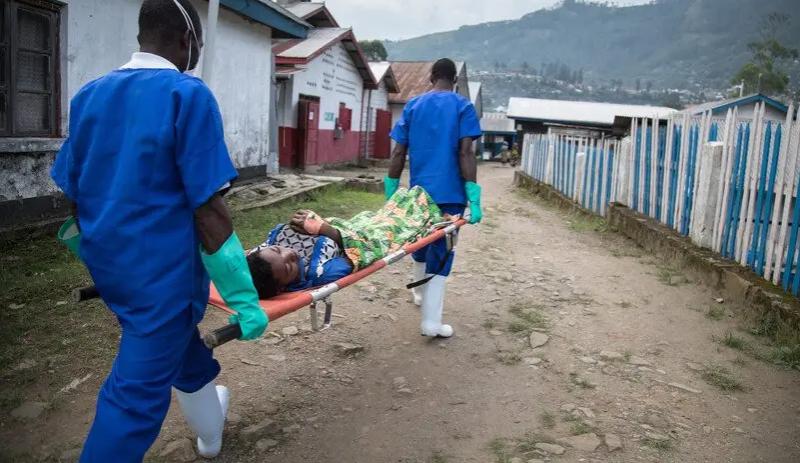
While countries in the global south contribute less than 10 percent of greenhouse gas emissions, they are likely to suffer the largest health impacts from climate change. Our recent study on dengue exemplifies how climate change and population growth expanded the risk of dengue transmission in the Global South. Not only are developing countries more at risk of climate disasters and harm, but they also have less adaptive capacity and preparedness to respond to these threats, making developing countries highly vulnerable (low preparedness vs climate risk).
The urgency of addressing the nexus between climate change and infectious diseases cannot be overstated. The response to climate change should be used as an opportunity to build capacity to protect and support health, especially in underserved and underrepresented communities. As responsible researchers and policymakers, it is imperative that we acknowledge this reality and take swift, decisive action to mitigate the impending public health crisis.
We urge governments, academic institutions, scientists, public health officials, private sector industries and health organizations to collectively address the urgent and interconnected challenges of climate-amplified diseases and epidemics through their diverse expertise, resources, and influence.
Figure 1: Two medical workers transfer a patient from the cholera treatment unit of Médecins Sans Frontières to the intensive care unit at the general hospital in Masisi, in the east of the Democratic Republic of the Congo. Credit: Alexis Huguet/AFP via Getty Images.
SUMMARY OF KEY MESSAGES & ACTION POINTS
Key messages
1. Reporting outbreaks timeously
2. Strengthen Genomic Surveillance
Action points
Governments and health organizations should commit to reporting outbreaks promptly and openly, sharing crucial data with relevant stakeholders. Transparency is essential for global preparedness and response efforts.
Governments, academic institutions, and health organizations must invest in and expand genomic surveillance capabilities to monitor the spread and evolution of infectious diseases. This will enable early detection and response to emerging threats, allowing us to prevent outbreaks before they escalate.
3. Prioritizing Vulnerable Populations
4. Promoting Climate Resilience
The most vulnerable communities are disproportionately affected by the intersection of climate change and infectious diseases.
Governments and private sector industries must prioritize these populations by investing in resilient healthcare systems, infrastructure, and disaster preparedness measures.
Academic institutions and private sector industries should collaborate to develop innovative solutions that enhance climate resilience within healthcare systems. This includes designing infrastructure to withstand extreme weather events and ensuring the availability of essential medical supplies during crises.
5. Committing Sustainable Funding
Governments, private sector industries, and health organizations must commit to sustainable funding dedicated to the fight against climate change-related infectious diseases. This funding should support research, capacity-building, and community engagement to create a robust defense against these converging threats.
MECHANISMS
OF DISEASE AGGRAVATION:
A. Observed Slow Rise in Temperature and Increased Risk of Epidemics
A.1 Global mean surface temperatures reached a record breaking 1·61°C above pre-industrial times between May 2023 and April 202410 with increasingly frequent and intense extreme heat events globally1112 The increase in temperature gradually alters the likelihood of disease transmission as environmental conditions become more favourable for certain disease vectors. An increase in viruses and parasites causing outbreaks has been noticed around the world. In 2024, the largest epidemic of dengue was recorded globally. There are also increasing rates of transmission of malaria, with resistance strains emerging in East Africa. West Nile Virus is resurging in Europe and North America with many countries and states identifying the first local transmission of these pathogens. In Africa, arboviral outbreaks are increasingly being detected, with Ethiopia having two dengue outbreaks in 2023-2024. Senegal has had concurrent outbreaks of dengue and chikungunya and countries are experiencing more frequent yellow fever virus outbreaks.
A.1.1
A.1.2
In 2024, dengue cases reached record highs with over 12 million cases reported from 70 countries globally. An estimated four billion people are at risk of infection from arboviruses around the world, and this number is estimated to increase to 5 billion by 2050
The climate suitability of dengue virus transmission has increased over the last four decades, particularly in Africa, the Indian subcontinent, Southeast Asia and coastal areas of continental Europe (Figure 2). In the Global South, this was accompanied by population growth in areas with favourable climates for dengue transmission, further compounding the problem13 .
A.1.3 In 2024, Ethiopia experienced a large dengue outbreak. Serotyping and sequencing of the DENV-positive samples revealed co-circulation of DENV1 and DENV3 and phylogenetic analysis showed close evolutionary relationship to the 2023 Italian outbreak and isolates from India14 .
A.1.4 The tiger mosquito (Aedes albopicus) is increasing in frequency in the south of Europe and fuelling new viral outbreaks. Last year, a British woman was infected with dengue virus while traveling in France15 In 20232024, there were reports of outbreaks of dengue virus in France16 and multiple cases of local transmission detected in the Lombardy and Lazio regions of Italy.
“Extreme temperatures, droughts, floods and cyclones cause death directly and indirectly through outbreaks of diseases such as cholera and dengue fever that are being witnessed in 16 and 7 African countries respectively.”
Nicksy
GumedeMoeletsi World Health Organization Regional Office for Africa
10 Romanello M, et al. The 2024 report of the Lancet Countdown on health and climate change: facing record-breaking threats from delayed action. The Lancet 2024; 404: 1847–96.
11 World Meteorological Organization. WMO state of the global climate 2023. 2023 https://library.wmo.int/viewer/68835/ download?file=1347_Statement_2023_en.pdf&type=pdf&navigator=1 (accessed Nov 17, 2024)
12 Chambers J. Global and cross-country analysis of exposure of vulnerable populations to heatwaves from 1980 to 2018. Climatic Change 2020; 163: 539–58.
13 Nakase T, et al. Population at risk of dengue virus transmission has increased due to coupled climate factors and population growth. Commun Earth Environ 2024; 5: 475.
14 Abera A, et al. Genomic characterization of Dengue virus circulation in Ethiopia. 2024; DOI:10.1101/2024.07.10.24310195.
15 Noyce E. British woman infected with dengue fever on holiday to France. Independent. https://www.independent.co.uk/news/health/dengue-france-british-woman-cases-b2319050.html (accessed Nov 18, 2023).
16 Head M. Dengue in France: tropical diseases in Europe may not be that rare for much longer. The Conversation 2022. https://theconversation.com/dengue-in-france-tropical-diseases-in-europe-may-not-be-that-rare-for-much-longer-191033 (accessed Oct 2, 2023).
Most of southern Europe is now susceptible to outbreaks of arboviruses.
A.1.5 As of 6 November 2024, 19 European countries have reported human cases of West Nile Virus (WNV) for 2024. Climate change has been shown to be a critical driver of the increased risk of WNV circulation in Europe, facilitating its establishment in the south-eastern region of the continent. The enhanced ecological suitability of the virus coincides with the rapid warming of the region since the 1980s.17
A1.6 Recent biogeographic modelling shows the climate-induced risk of WNV outbreaks in the Afrotropical region will increase by approximately 1% by 2040 and 3.6% in 2070, particularly in coastal areas of Nigeria and Cameroon, as well as in countries such as Mali, Mauritania, Botswana, Namibia and South Africa18 .
A1.7 In 2023, Colorado, in the USA, experienced the worst WNV outbreak so far. And it’s been one of the deadliest WNV seasons in Colorado since the mosquito-borne illness arrived in the U.S. back in 1999. By Sept. 1, 2023, 11 people had died in Colorado due to WNV19 Between 1999 and 2023, WNV has caused 59,000 infections and 2,900 deaths in the USA19 .
A1.8 Malaria cases are increasing again in East Africa and Asia. Artemisinin resistance (ART-R) is emerging with kelch13 markers in Africa and it is likely only a matter of time before these begin to spread widely across the continent20 21 (Figure 3) There has been a decrease on funding for malaria over the past 5 years and this, together with political instability and other public health priorities, such as the COVID-19 pandemic, has diverted already limited resources away from genomic surveillance of P. falciparum, jeopardising the surveillance of ART-R in Africa2223. This means continuing surveillance is vital, not only for containing the spread of ART-R, but also for minimising the human costs it will cause as Artemisinin is the last line of therapy to malaria.
A1.9 With global climate change, more areas even those away from the equator or at relatively high elevations are being invaded by mosquitoes. The first ever locally transmitted cases of malaria were detected in the USA, including in Texas, Florida, Maryland and Arkansas in 202324, 25
A1.10 Increasing temperatures in southern Europe have also been linked to a chikungunya epidemic in Italy in 201726 that spread in the Lazio region and caused a secondary outbreak in the Calabrian village of Guardavalle in 2023.
17 Erazo D, et al Contribution of climate change to the spatial expansion of West Nile virus in Europe. Nat Commun 2024; 15: 1196.
18 García-Carrasco J, et al. Present and future situation of West Nile virus in the Afro-Palaearctic pathogeographic system. Ecography 2024; 2024: e06941.
19 McCrimmon KK. Colorado experiencing worst West Nile virus outbreak in U.S. this year. So far, 11 people have died. UCHealth Today. 2023; https://www.uchealth.org/today/colorados-west-nile-virus-outbreak-worst-in-us-this-year/ (accessed Oct 2, 2023).
20 Dhorda M, et al. Artemisinin-resistant malaria in Africa demands urgent action. Science 2024; 385: 252–4.
21 Rosenthal PJ, Asua V, Conrad MD. Emergence, transmission dynamics and mechanisms of artemisinin partial resistance in malaria parasites in Africa. Nat Rev Microbiol 2024; 22: 373–84.
22 Mensah BA, et al Genomic approaches for monitoring transmission dynamics of malaria: A case for malaria molecular surveillance in Sub–Saharan Africa. Front Epidemiol 2022; 2: 939291.
23 Balmer AJ, et al. Understanding the Global Spread of Artemisinin Resistance: Insights from over 100K Plasmodium falciparum Samples. 2024; DOI:10.1101/2024.08.23.609367.
24 Centers for Disease Control and Prevention. Locally Acquired Cases of Malaria in Florida, Texas, and Maryland. Atlanta: CDC https://www.cdc.gov/malaria/new_info/2023/malaria_florida.html#:~:text=Locally%20Acquired%20Cases%20of%20Malaria%20in%20Fl orida%2C%20Texas%2C%20and%20Maryland,Locally%20Acquired%20Cases&text=CDC%20is%20collaborating%20with%20three,and%20one%20case%20of%20P (accessed Oct 2, 2023).
25 Schnirring L. Arkansas reports locally acquired malaria. Arkansas Department of Health. 2023; published online Oct 5. https://www.cidrap.umn.edu/malaria/arkansas-reports-locally-acquired-malaria-case (accessed Oct 5, 2023).
26 Rezza G. Chikungunya is back in Italy: 2007-2017. J Travel Med 2018; 25. DOI:10.1093/jtm/tay004
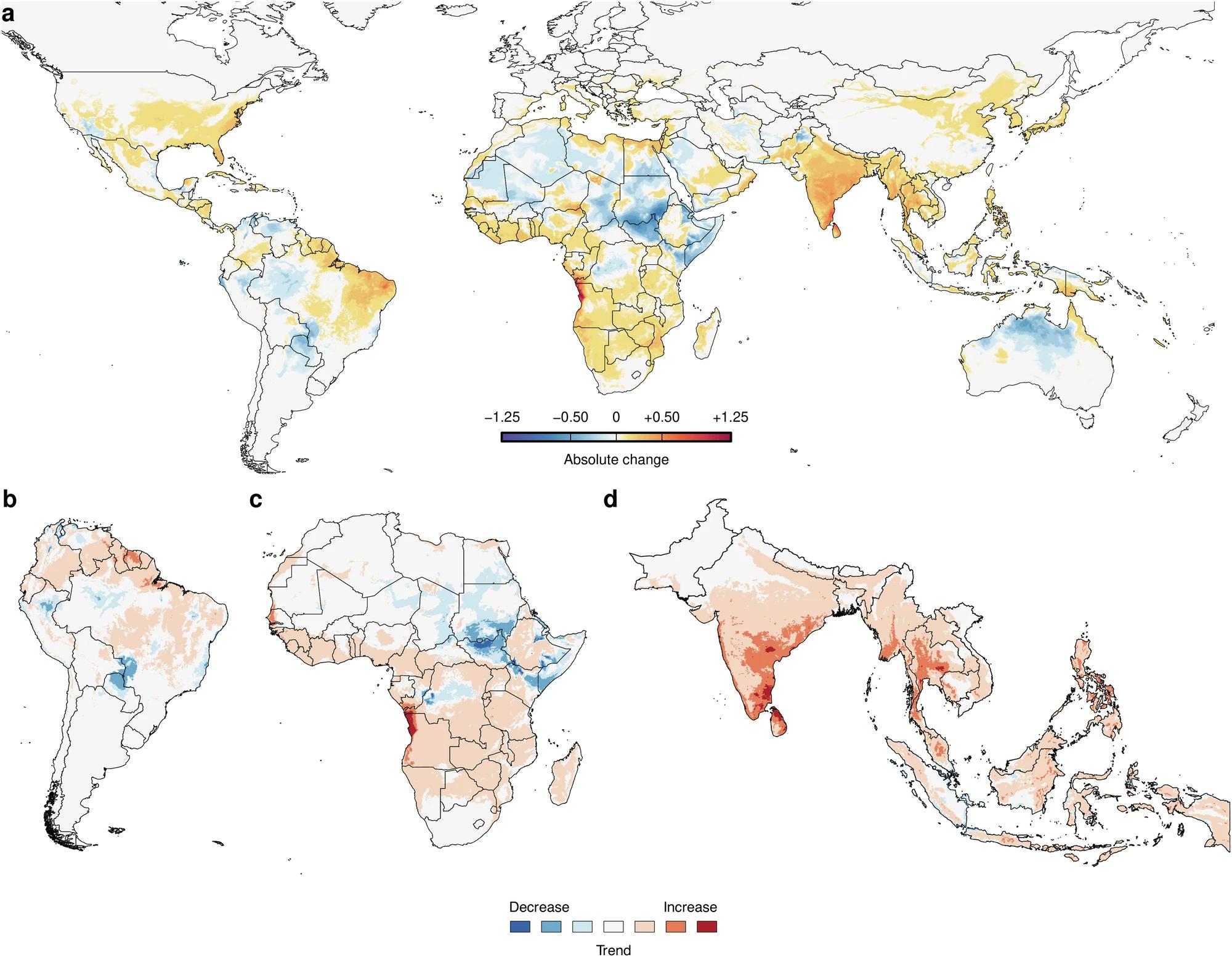
Figure 2: a Absolute change in climate suitability on the Index P scale between 1979–1983 (past) to 2018–2022 (present). b–d Estimated trend in climate suitability for dengue virus transmission per pixel using monthly Index P time series from 1979 to 2022 for Africa, South America and South Asia/South-East Asia Pixels with trends that are not significant at a false discovery rate (FDR) < 0.10 are coloured white. 27
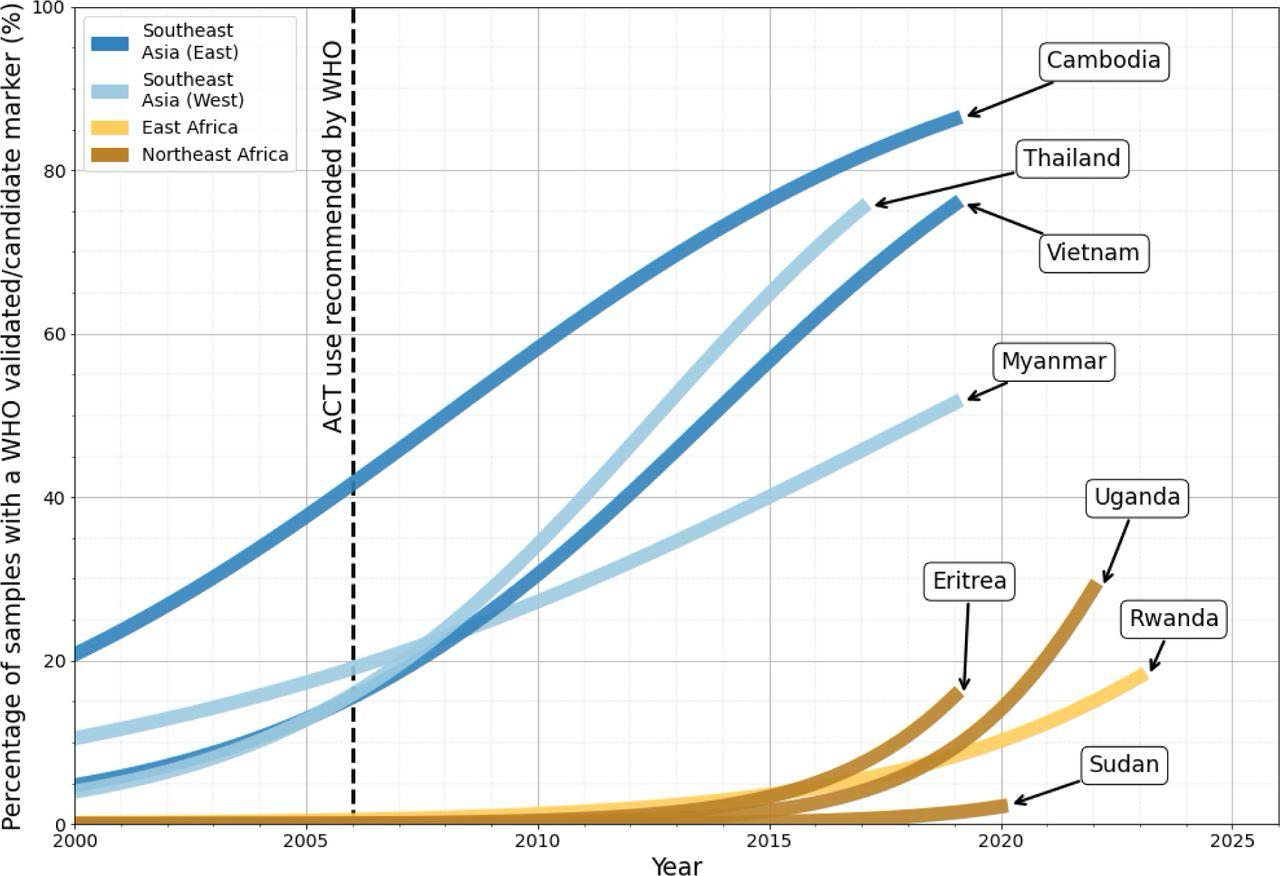
Figure 3: Proportion of samples with a WHO validated/candidate kelch13 mutations over time. The black dashed line highlights 2006the year in which the WHO recommended Artemisinin based (ACT) therapy as a first-line treatment measure in Africa (WHO, 2006). Notably, the rapid increase in prevalence of WHO kelch13 markers in East and Northeast African countries is similar to that observed in Southeast Asian countries between 2007 and 2016. Source:28
27 Nakase, T, et al. Population at risk of dengue virus transmission has increased due to coupled climate factors and population growth. Commun Earth Environ 5, 475, 2024. https://doi.org/10.1038/s43247-024-01639-6
28 Balmer AJ, et al. Understanding the Global Spread of Artemisinin Resistance: Insights from over 100K Plasmodium falciparum Samples. 2024; DOI:10.1101/2024.08.23.609367.
B. Extreme climate events are driving the rise in epidemics
B.1 Delay in climate change mitigation and adaptation have intensified extreme climate events impacts. Record-breaking extreme weather events were registered worldwide in 2023 and 2024, with extreme heatwaves, wildfires, storms, floods, and droughts affecting people and the systems and economies on which their health depends. The aftermath of such disasters can be further compounded by the rapid spread of infectious diseases. Extreme cholera epidemics were detected in south Asia and Africa in 2022-2024. Contamination of water with e coli after floods has been detected in multiple regions of the world. Floods have amplified the likelihood of mosquitoes breeding, subsequently leading to an increase in malaria and dengue transmission across many parts of the world, especially in Southeast Asia.
B.1.1 Infectious disease outbreaks following extreme weather events occur as microbes, vectors, and reservoir animal hosts take advantage of the disrupted social and environmental conditions resulting from such weather extremes.
B1.2 Exposure to extreme floods or floods lasting more than two weeks is associated with a higher prevalence of diarrhoea among children younger than five years old living in low- and middleincome countries of Africa, South America and South Asia. Given the anticipated rise in the frequency and severity of floods and droughts due to climate change, it is essential to safeguard children from this health threat.
B1.3 Many regions of Afghanistan have been battered by extreme precipitation and severe flooding between March and July of 2024. This recurring heavy rainfall and flash flooding has led to a deadly Vibrio cholera outbreak: From 1 January 2024 to 12 October 2024, 149,622 cases and 72 deaths have been reported from across the country29 . 30
B1.4 Numerous studies have also shown an increase in incidence of viral mosquito-borne diseases such as West Nile, Zika, dengue and chikungunya, following hurricanes in parts of the US, Puerto Rico and Haiti31
B1.5 On August 25, 2022, Pakistan declared a national emergency in response to catastrophic flooding, marking it the worst such disaster in the country since 2010. In the aftermath of this extreme event, an unexpected rise in dengue cases overwhelmed hospitals32 (Figure 4)
B1.6 Furthermore, floods have amplified the likelihood of mosquitoes breeding, subsequently leading to an increase in malaria transmission across many parts of the world, especially in Southeast Asia. In Pakistan, malaria cases increased four-fold to 1.6 million following the devastating floods in 2022 that left a third of the country under water33 .
B1.7 Extreme climate events and health data is still poorly collected. The data is commonly not stratified by vulnerable population groups, including Indigenous peoples, women, children, people from minority ethnic backgrounds. Data scarcity limits the capacity to reflect the disproportionate impact of climate change on vulnerable groups. This is a global challenge that hampers an efficient and equitable response to climate change.34 35 3637
29 Wang P, et al. Floods and Diarrhea Risk in Young Children in Low- and Middle-Income Countries. JAMA Pediatr 2023; 177: 1206.
30 World Health Organization. Afghanistan: Infectious Disease Outbreaks - Epidemiological Week #41 (06 - 12 Oct 2024) Situation Report #41. Geneva, Switzerland: World Health Organization, 2024.
31 Cox D. Cholera, Zika and West Nile: The deadly diseases that sweep in after hurricanes. BBC. 2024; published online Nov 2. https://www.bbc.com/future/article/20241031-why-hurricanes-can-bring-cholera-zika-west-nile-and-flesh-eating-bacteria (accessed Nov 18, 2024).
32 Shaikh OA, et al. Dengue outbreak following unprecedented flooding in Pakistan. Hyg Environ Health Adv 2023; 7: 100076.
33 Samarasekera U. Climate change and malaria: predictions becoming reality. The Lancet 2023; 402: 361–2.
34 Shaikh OA, et al. Dengue outbreak following unprecedented flooding in Pakistan. Hygiene and Environmental Health Advances 2023; 7: 100076.
35 Norton-Smith K, et al Climate change and indigenous peoples: a synthesis of current impacts and experiences. Pacific Northwest Research Station: US Department of Agriculture, Forest Service, 2016.
36 Ebi KL, Paulson JA. Climate Change and Children. Pediatric Clinics of North America 2007; 54: 213–26.
37 Hansen A, et al. Vulnerability to extreme heat and climate change: is ethnicity a factor? Global Health Action 2013; 6: 21364
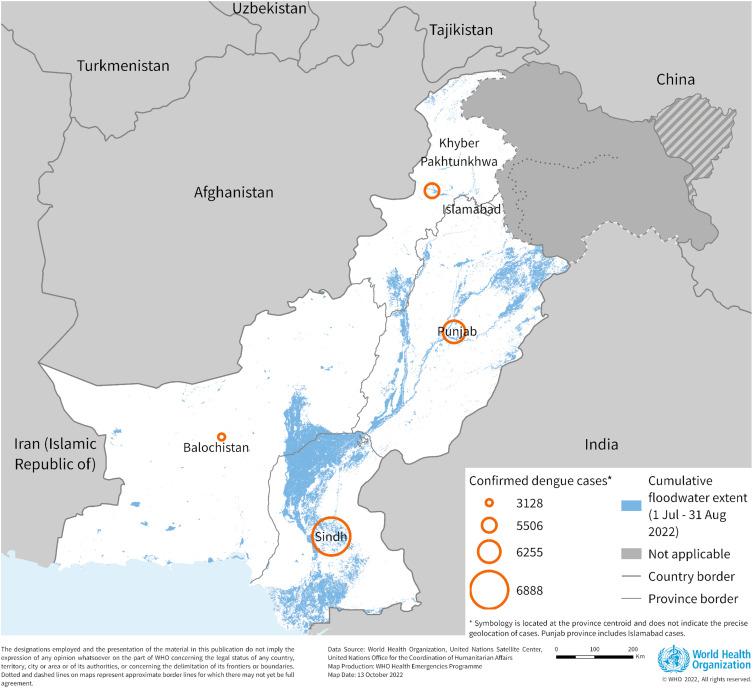
“Climate change has caused a lot of outbreaks of arboviruses in the highlands and midlands of Ethiopia which were not present in the country previously. Now chikungunya and dengue fever viruses are becoming common outbreaks in the eastern part of our country.”
Molalegne Bitew Bio and Emerging Technology Institute, Ethiopia
38 World Health Organization. Disease Outbreak News: Dengue - Pakistan. Geneva, Switzerland: World Health Organization, 2022 https://www.who.int/emergencies/disease-outbreak-news/item/2022-DON414 (accessed Nov 20, 2024).
Figure 4: Distribution of confirmed dengue cases in Pakistan by province, 1 January to 22 September 2022. Source 38
C. Climate Migrants and Epidemics
C.1 Notably, in an increasingly globalized world, the movement of people, animals, and cargo can further compound the challenges of climate change and epidemics. As demonstrated by the rapid spread of SARS-CoV-2 variants and Dengue serotypes, highly transmissible pathogens can easily cross borders despite severe travel restrictions. This means that pathogens can arrive undetected and cause epidemics if the conditions for transmission are appropriate. Scientists anticipate that 2024 will be an even warmer year because of the El Niño event (a climate pattern that results in the warming of surface waters in the eastern Pacific Ocean). This will likely produce severe drought in some regions of the world, potentially spurring mass temporary and permanent migrations.
C.1.1 Climate change can also drive populations to migrate, causing more interactions with wildlife and increasing the risk of spillover of pathogens. According to reports from the Internal Displacement Monitoring Centre, climate extreme events in 2022 caused >100,000 people to be displaced internally (Figure 5)39
C.1.2 Migrations following extreme weather events have caused outbreaks of cholera in Haiti and Bangladesh40,41 .
C.1.3 Hepatitis E virus (HEV) outbreaks have occurred in displaced persons camps linked to unclean water supply, low hygiene, and sanitation standards. Severe droughts in the Horn of Africa in 2011 aggravated socio-economic issues in the region, including increased food-insecurity42. This led to population displacements into overcrowded refugee camps in Kenya and Ethiopia, where devastating outbreaks of cholera, shigellosis, and acute HEV have followed43,44
C.1.4 Risk of importation modelling of dengue in Africa shows increased risks of epidemics in African countries following dengue introductions from South Asia. The results show that most introductions from Brazil are likely to fall within cold-spots in Africa, whereas the introductions from South Asia are likely to fall in hot-spots and potentially cause large outbreaks45 .
C.1.6 After the SARS-CoV-2 pandemic, shifts in global mobility patterns impacted on the synchrony of epidemic waves on different continents, suggesting the potential of global outbreaks fuelled by human movements46 . Advanced phylogeographic mapping of variants global dispersal dynamics revealed that global dispersal of pathogens happens along well-connected travel hubs and along air traffic networks, providing support to the simultaneous movement of pathogens along with human mobility47 .
C.1.7 Human migration resulting from climate pressures has been linked to changes in the geographical distribution of disease vectors as they are introduced to new ecological areas48. For example, during the yellow fever virus (YFV) epidemic in Brazil, frequent movements to rural and forested
39 Tsui JLH, Pena RE, Moir M, Inward RPD, Wilkinson E, San JE, Poongavanan J, Bajaj S, Gutierrez B, Dasgupta A, de Oliveira T, Kraemer MUG, Tegally H, Sambaturu P. Impacts of climate change-related human migration on infectious diseases. Nat. Clim. Chang. 2024; 14, 793–802.
40 Reiner RC, et al. Highly localized sensitivity to climate forcing drives endemic cholera in a megacity. Proc Natl Acad Sci USA 2012; 109: 2033–6.
41 Rinaldo A, et al. Reassessment of the 2010–2011 Haiti cholera outbreak and rainfall-driven multi-season projections. Proc Natl Acad Sci USA 2012; 109: 6602–7.
42 Willett J, Sears J. Complicating our understanding of environmental migration and displacement: The case of drought -related human movement in Kenya. Int. Soc. Work 2020; 63: 364–70
43 Ahmed JA, et al. Hepatitis E outbreak, Dadaab refugee camp, Kenya, 2012. Emerg. Infect. Dis. 2013; 19: 1010–12.
44 Golicha Q, et al. Cholera Outbreak in Dadaab Refugee Camp, Kenya - November 2015-June 2016. Morb. Mortal. Wkly. Rep. 2018; 67: 958–61.
45 Poongavanan J, et al. Disentangling seasonal introduction and establishment risk of dengue in Africa. Lancet Planetary Health 2024; in press
46 Tegally H, et al. Shifts in global mobility dictate the synchrony of SARS-CoV-2 epidemic waves, Journal of Travel Medicine 2022; 29 (8) https://doi.org/10.1093/jtm/taac134
47 Tegally H, et al Dispersal patterns and influence of air travel during the global expansion of SARS-CoV-2 variants of concern. Cell 2023; 186(15): 3277 - 90.
48 Wilder-Smith A, Gubler DJ. Geographic expansion of dengue: the impact of international travel. Med. Clin. North Am 2008; 92: 1377–90.
Summary for Policymakers
areas have been shown to be associated with an increased risk of acquiring YVF from the sylvatic cycle (the transmission of virus between non-human primates and forest-canopy mosquitoes)49 .
C.1.8 Factors such as overcrowding and poor sanitation associated with climate disasters and human migrations may lead to outbreaks of mosquito-borne disease (e.g., malaria and dengue) and water-borne diseases (e.g., cholera, hepatitis A) in the destination location of the displaced population 50,51,52
C.1.9 Close proximity to vectors and animal populations near temporary shelters may further exacerbate the risk of zoonotic spillovers. For example, it was shown by Thompson et al (2002) 53 that there was an elevated risk of visceral leishmaniasis near water supplies in northeastern Brazil, where sand fly vectors are prevalent because of an increase in human settlements driven by drought events.
C.1.10 The increased urbanisation and population density as a result of long-term migration events has been shown to impact infectious disease transmission dynamics54,55,56,57
C.1.11 The projected populations at risk are not distributed equally, with population growth and urbanization rates expected to be highest in sub-Saharan Africa over the coming decades, posing considerable challenges to younger generations dealing with the adverse health impacts of climate change The majority of African countries are faced with the greatest share of the global infectious disease burden, followed by countries in Asia (Figure 6)57
49 Faria NR, et al. Genomic and epidemiological monitoring of yellow fever virus transmission potential. Science 2018; 361: 894–9.
50 Chaparro P, Padilla J, Vallejo AF, et al. Characterization of a malaria outbreak in Colombia in 2010. Malar. J. 2013; 12: 330
51 Siddique AK, et al. Why treatment centres failed to prevent cholera deaths among Rwandan refugees in Goma, Zaire. Lancet 1995; 345: 359–61.
52 Public health impact of Rwandan refugee crisis: what happened in Goma, Zaire, in July, 1994? Goma Epidemiology Group. Lancet 2005; 345: 339–44.
53 Thompson RA, et al. Climatic and demographic determinants of American visceral leishmaniasis in northeastern Brazil using remote sensing technology for environmental categorization. Am. J. Trop. Med. Hyg. 2002; 67: 648–55.
54 Gurram MK, et al Impact of urbanisation and environmental factors on spatial distribution of COVID-19 cases during the early phase of epidemic in Singapore. Sci. Rep. 2022; 12: 9758.
55 Tandon N, et al. Emerging Work Trends in Urban India: Covid-19 and Beyond. Routledge Chapman & Hall, 2022.
56 Reyes R, et al. Urbanization and Infectious Diseases: General Principles, Historical Perspectives, and Contemporary Challenges. In: Challenges in Infectious Diseases (ed. Fong IW). pp 123–146. Springer, New York, 2013.
57 Neiderud C-J. How urbanization affects the epidemiology of emerging infectious diseases. Infect. Ecol. Epidemiol. 2015; 5: 27060.
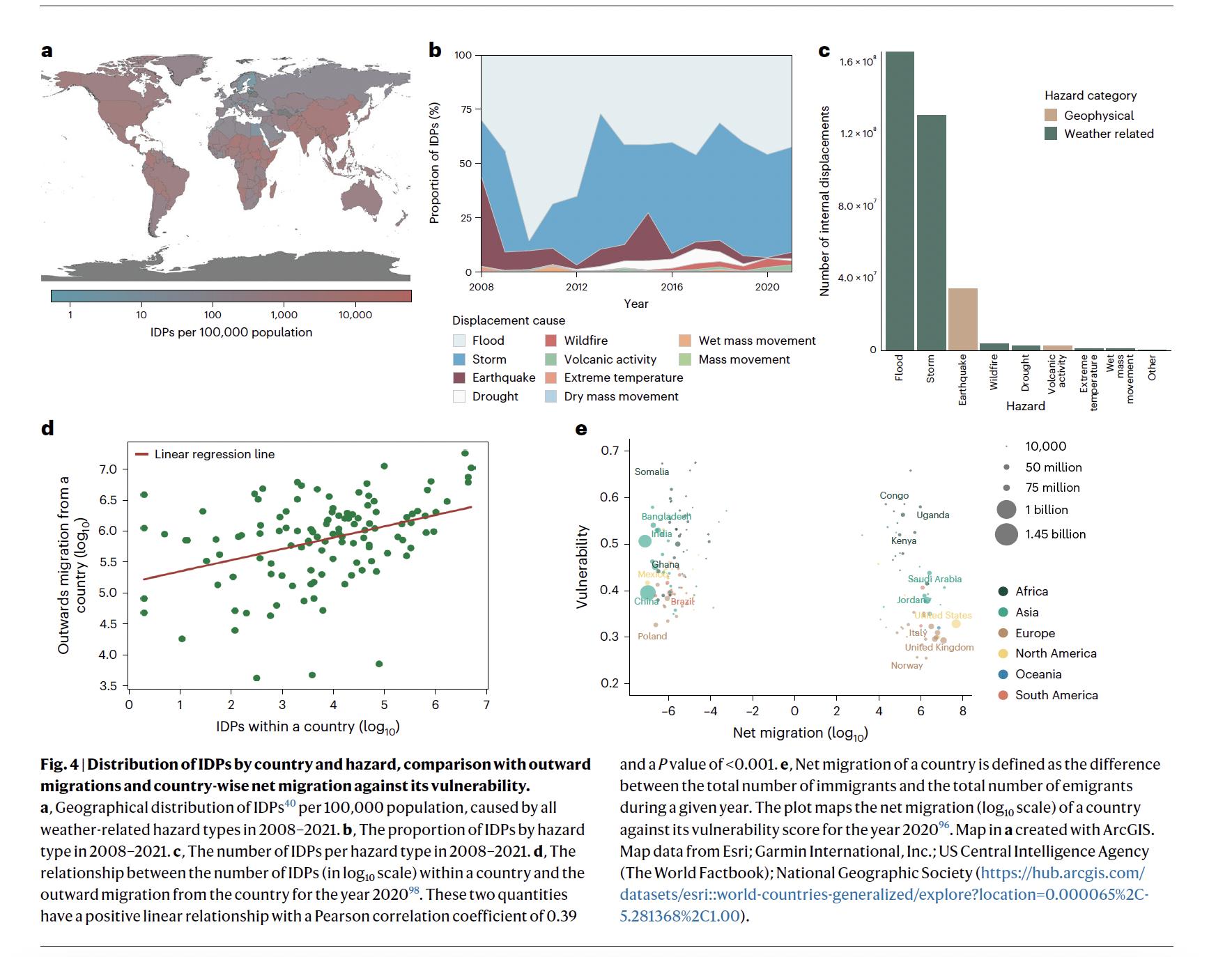
Figure 5 Distribution of internally displaced persons (IDPs) by country and hazard, comparison with outward migrations and countrywise net migration against its vulnerability. a, Geographical distribution of IDPs40 per 100,000 population, caused by all weatherrelated hazard types in 2008 2021. c, The number of IDPs per hazard type in 2008 and the outward migration from the country for the year 2020. e, Net migration of a country is defined as the difference between the total number of immigrants and the total number of emigrants during a given year. The plot maps the net migration (log10 scale) of a country against its vulnerability score for the year 2020. Map in a created with ArcGIS. Map data from Esri; Garmin International, Inc.; US Central Intelligence Agency (The World Factbook); National Geographic Society. Source:58
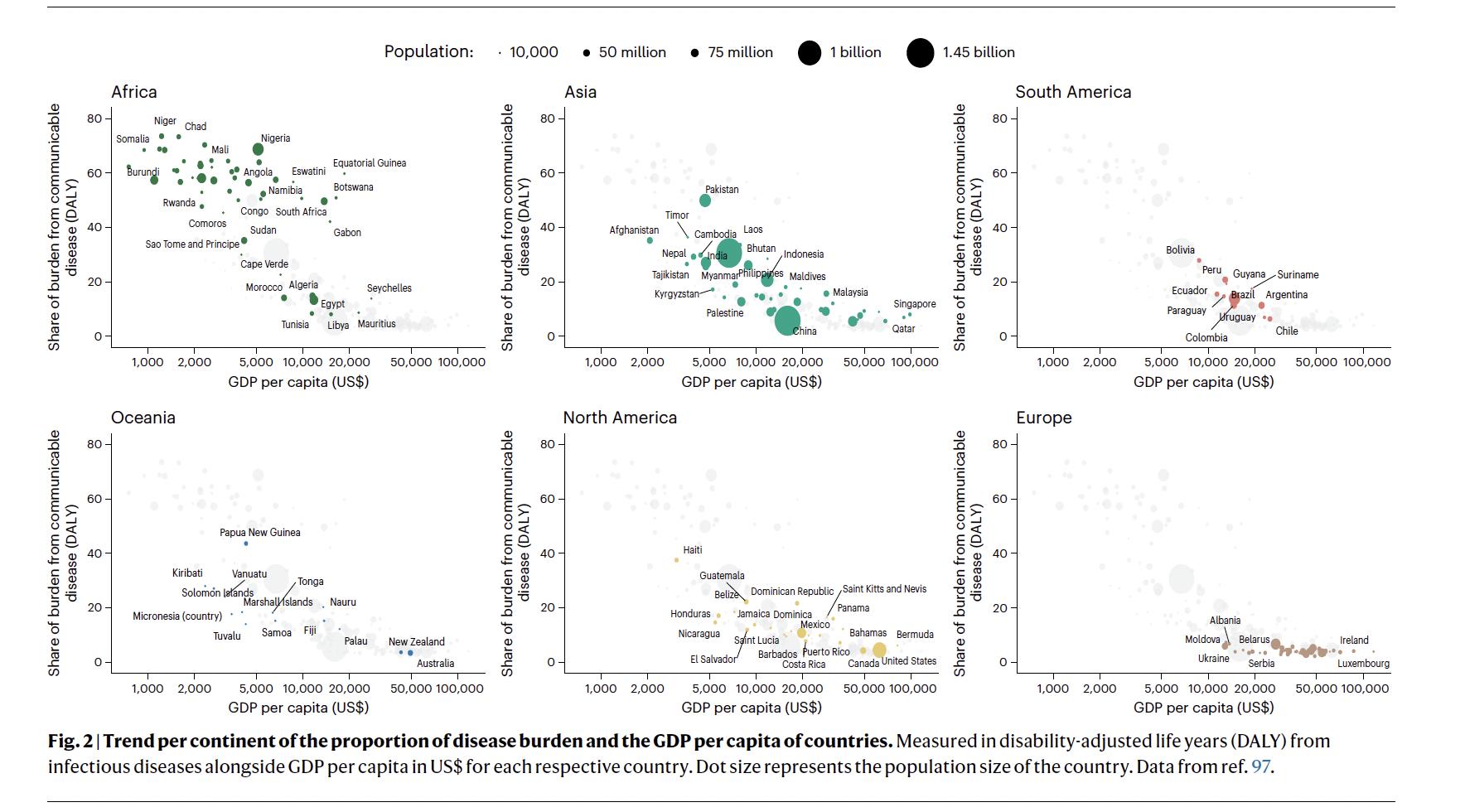
Fig adjusted life years (DALY) from infectious diseases alongside GDP per capita in US$ for each respective country. Dot size represents the population size of the country. Source:
climate change-related human migration on infectious diseases. Nat. Clim. Chang. 2024; 14, 793–802
58 Tsui JLH, Pena RE, Moir M, Inward RPD, Wilkinson E, San JE, Poongavanan J, Bajaj S, Gutierrez B, Dasgupta A, de Oliveira T, Kraemer MUG, Tegally H, Sambaturu P. Impacts of
D. Creation of a Global Consortium on Climate Amplified Epidemics and Diseases (CLIMADE)
D.1 The CLIMADE (Climate Amplified Diseases & Epidemics) consortium brings together leading global scientists focused on bridging knowledge gaps, improving surveillance tools and expanding adequate interventions to decrease the impact of diseases and epidemics amplified by climate change. The overarching long-term goal of CLIMADE is to predict, track and control diseases and epidemics that are amplified by human-caused climate change in the most affected countries in the world.
D.1.1 The mission of CLIMADE is to use the medical, scientific, and public health experience of epidemics in the global south to help the world create a robust surveillance system to quickly identify pathogens and track their evolution and spread to control outbreaks before they become epidemics and epidemics before they become pandemics.
D.1.2 The CLIMADE consortium brings together partners from around the globe that have long-term experience with pathogen genomics and epidemics that are amplified by climate change (Figure 7). Partners include public health agencies, academic organizations, and industry. The CLIMADE consortium is led by Professor Tulio de Oliveira, from the CERI in South Africa, Professor Luiz Carlos Alcantara, from the Fundação Oswaldo Cruz (FIOCRUZ) in Brazil, and Professor Edward C Holmes, from the University of Sydney in Australia. Together, with key public health agencies such as the Africa CDC and the WHO/PAHO, they bring decades of experience in genomics surveillance and epidemic response and have assembled a leading team of academic and industrial experts to start developing the global CLIMADE network.
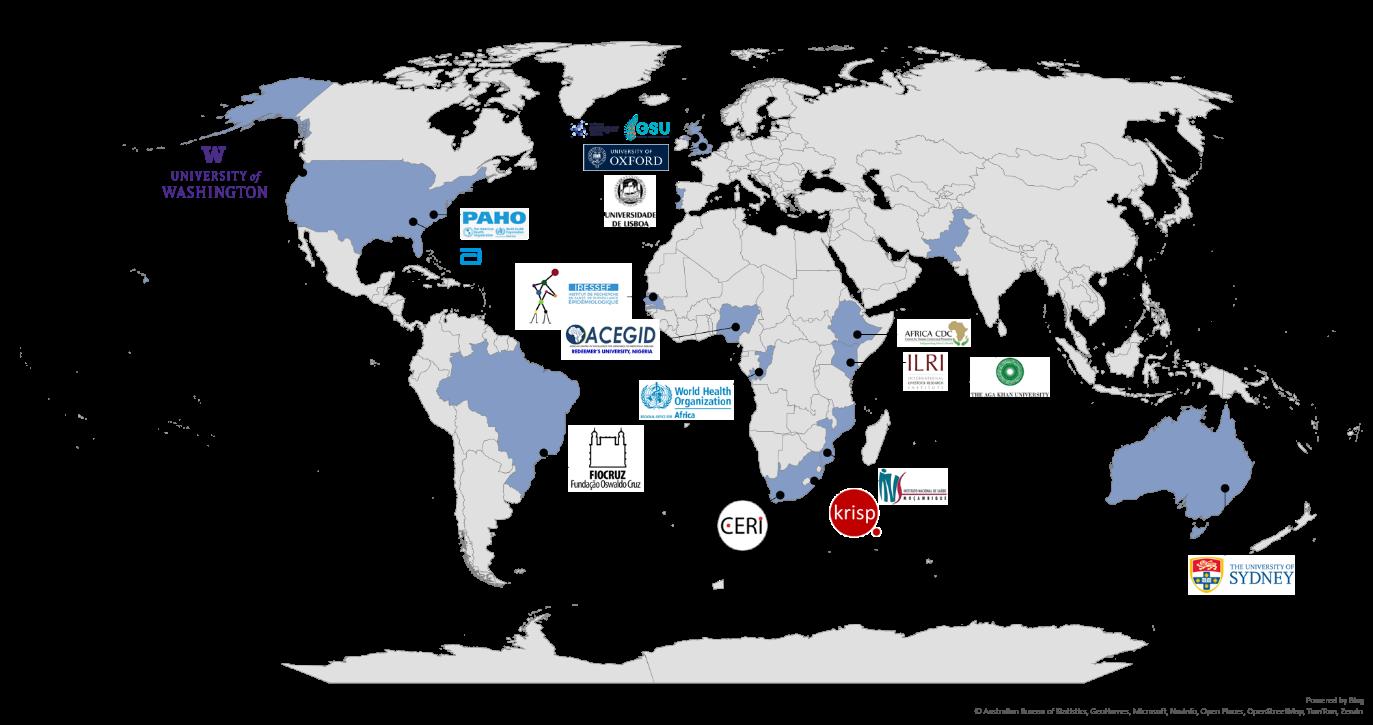
E. CLIMADE Featured Work: Amplifying Oropouche virus (OROV) outbreaks in South America as a warning for disease ecological tipping points
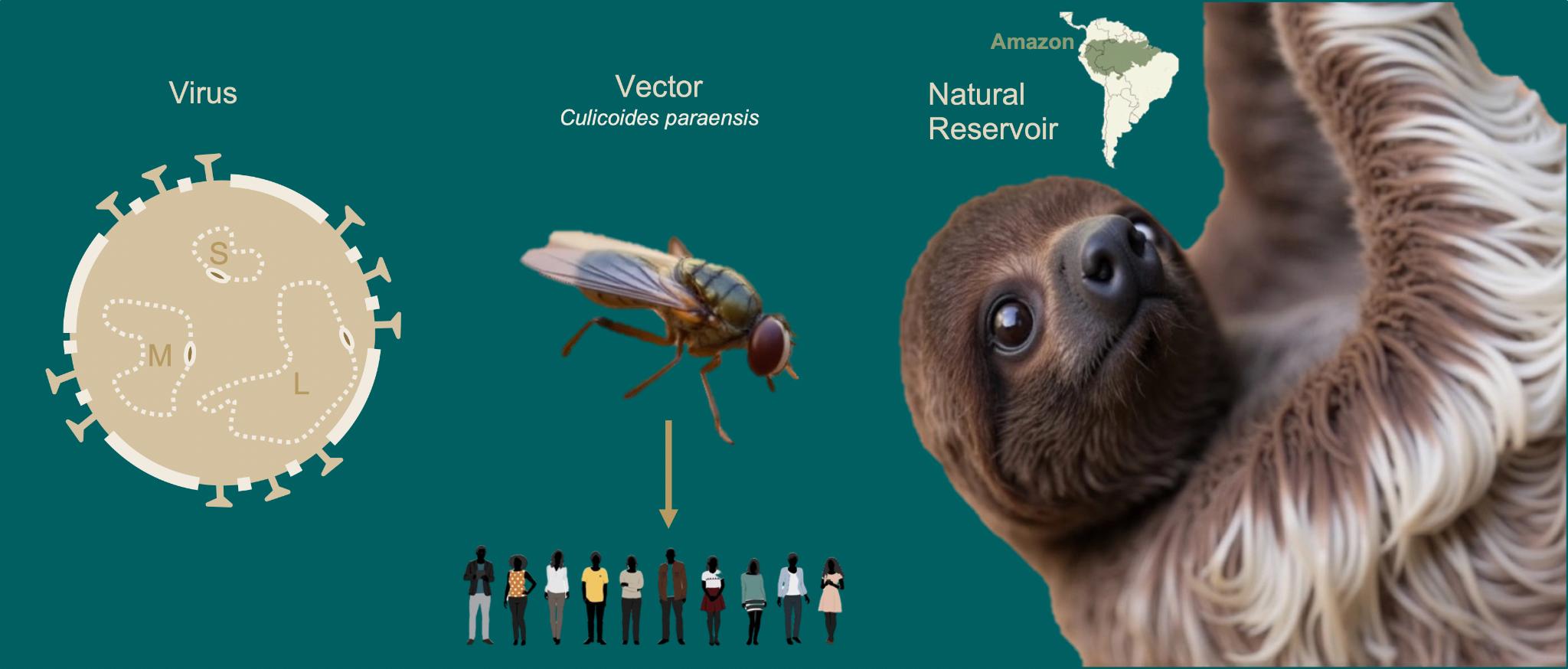
E.1 OROV is a neglected tropical disease endemic to the Amazon region and spread by biting midges as its primary vector. As of October 2024, a complex epidemiological event is unfolding in South America: PAHO reported over 10,000 confirmed cases of Oropouche virus (OROV), in six countries across South America59. Importantly, OROV is also underdiagnosed in returning travellers globally and migrants in the US, facilitating the introduction and establishment of the virus in the country60. Recent epidemiological data and genomic investigations in Brazil61 62 63 have described the recent expansion of OROV into regions that were previously non-endemic, including the reporting of severe clinical symptoms64. These studies have identified reassortment events in the virus's genome, which may have contributed to its changing epidemiology.
E.1.1 Utilising phylogeographic approaches, we reveal a multi-scale expansion process with both short and long-distance dispersal events, and diffusion velocities in line with human-mediated jumps. We identify forest cover, banana and cocoa cultivation, temperature, and human population density as key environmental factors associated with OROV range expansion (Figure 8).
E1.2 Using ecological niche modelling, we show that OROV circulated in areas of enhanced ecological suitability immediately preceding its explosive epidemic expansion in the Amazon. This likely resulted from the virus being introduced into simultaneously densely populated and environmentally favourable regions in the Amazon, such as Manaus, leading to an amplified epidemic and spread beyond the Amazon.
59 Epidemiological Update Oropouche in the Americas Region - 15 October 2024 - PAHO/WHO | Pan American Health Organization [Internet]. [cited 2024 Nov 12]. Available from: https://www.paho.org/en/documents/epidemiological-update-oropouche-americas-region15-october-2024
60 Morrison A, et al. Oropouche Virus Disease Among U.S. Travelers - United States, 2024. MMWR Morb Mortal Wkly Rep. 2024;73(35):769–73.
61 Naveca FG, et al Emergence of a novel reassortant Oropouche virus drives persistent human outbreaks in the Brazilian Amazon region from 2022 to 2024. medRxiv. 2024 Jul 24
62 Iani FC de M, et al Rapid spatial Expansion Beyond the Amazon Basin: Oropouche Virus joins other main arboviruses in epidemic activity across the Americas. medRxiv. 2024 Aug 4
63 Tegally H, et al. Dynamics and ecology of a multi-stage expansion of Oropouche virus in Brazil. medRxiv. 2024 Oct 30
64 das Neves Martins FE, et al Newborns with microcephaly in Brazil and potential vertical transmission of Oropouche virus: a case series. Lancet Infect Dis. 2024 Oct 15
E1.3 These findings have several implications. First, by using complementary analytical methods and a comprehensive genomic data set, we identify key environmental factors important for virus transmission. Results from both approaches implicate human population density, banana and cocoa cultivation, and temperature as factors associated with favourable transmission environments. Such information can directly inform public health planning and mitigation measures, such as vector control activities around banana and cocoa plantations, particularly near urban areas. A recent study also implicated banana and cocoa as important crop types in epidemic locations65 .
E1.4 Second, while not a confirmation, our work provides a robust initial indication that OROV expanded opportunistically by finding more favourable environments for transmission, which were also more connected to the rest of the country. Other hypotheses have explored the idea that higher viral replication in mammalian cells could allow more efficient transmission to vector and onwards, or that the immune escape ability of the new reassortant lineage may play a role 66 .
E1.5 Synthesising recent work with our findings identifies a proposed mechanism for this emerging outbreak. It is possible that genetic reassortment resulted in a viral genotype characterised by more efficient infection and transmission between humans and the vector, resulting in higher viremia, in turn explaining the epidemic expansion in favourable urban environments detected in our study. The approach we propose is highly adaptable to risk mapping and the characterisation of disease ecology for other arboviruses and zoonotic infections.
E1.6 The geographic expansion of OROV into new regions highlights the pressing need for integrating environmental monitoring into public health frameworks. To effectively predict and mitigate the risks posed by OROV and other arboviruses, surveillance efforts must account for the complex interaction between environmental changes, vector ecology and human behaviour. As OROV continues to adapt to new ecological niches, driven by combinations of genetic evolution and both natural and anthropogenic factors, a deep understanding of these dynamics will be essential for developing targeted intervention strategies to control its spread and minimise its public health impact.
65 Gräf T, et al. Long-Range Spread and Sustained Transmission of Oropouche Virus Outside the Endemic Brazilian Amazon Region. 2024
Scachetti GC, et al Re-emergence of Oropouche virus between 2023 and 2024 in Brazil: an observational epidemiological study. Lancet
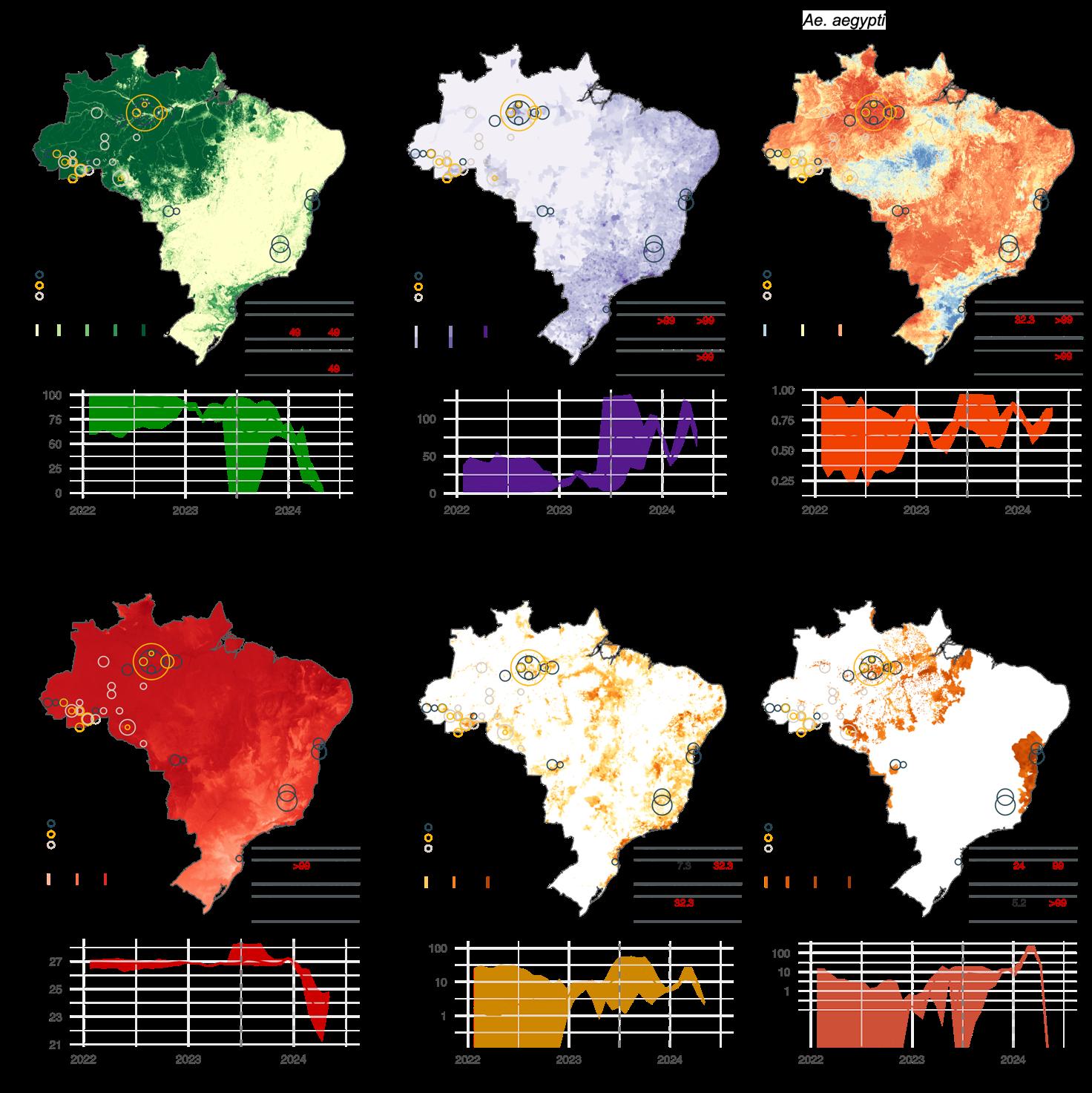
Figure 8. Environmental conditions associated with OROV lineage dispersal locations over time (for segment M). Figure panels show the spatial distribution of six main environmental factors (units specified): evergreen broadleaf forest cover (%) (A), human population density (normalised between 0 and 255 per km2 for visual clarity) (B), Ae. aegypti ecological suitability (probability of occurrence) (C), mean annual temperature (°C) (D), banana harvested area (in hectares, log-transformed) (E), and cocoa harvested area (in hectares, log-transformed) (F) in the top rows. Circles on the map depict the end node of dispersal locations inferred by continuous phylogeography, sized by the number of dispersal events in an area, and coloured by the timing of the event. Bottom rows of each figure panel are line graphs depicting the environmental covariates associated with the locations of OROV lineage dispersal events in Brazil. Each plot illustrates how specific ecological conditions have changed over time (2022-2024) at the sites of viral lineage dispersal67
67 Tegally et al. Dynamics and ecology of a multi-stage expansion of Oropouche virus in Brazil. medRXiV, 2024, doi: https://doi.org/10.1101/2024.10.29.24316328
F. Call for Action:
Join
the CLIMADE Consortium in Combating Climate-Amplified Diseases and Epidemics
F.1 Climate change and infectious diseases have emerged as intertwined challenges that demand our immediate attention. The impacts of climate change on health and disease are undeniable, and the governments, academic institutions, private sector industries, and health organizations must unite to combat this threat. It is imperative that we address this intersection of climate change and infectious diseases, prioritizing the most vulnerable populations and fostering health equity.
While countries in the global south contribute less than 10 percent of greenhouse gas emissions, they are likely to suffer the largest health impacts from climate change because of proximity to hotspots of disease emergence (biodiversity), an already high burden of infectious diseases in these countries, geographical association with the tropics where temperatures are high yearround, and critically, because of its large vulnerable populations, which typically have inadequate access to functional health systems.
Not only are developing countries more at risk of climate disasters and harm, but they also have less adaptive capacity and preparedness to respond to these threats, making developing countries highly vulnerable (low preparedness vs climate risk). The response to climate change should be used as an opportunity to build capacity to protect and support health, especially in underserved and underrepresented communities.
The time to act is now! The intersection of climate change and infectious diseases poses a formidable challenge to global health, and we cannot afford to delay our response. By taking these actions, we can work collectively to mitigate the impending public health crisis and build a more resilient, equitable world for all.
Call for Action 1: Reporting outbreaks timeously
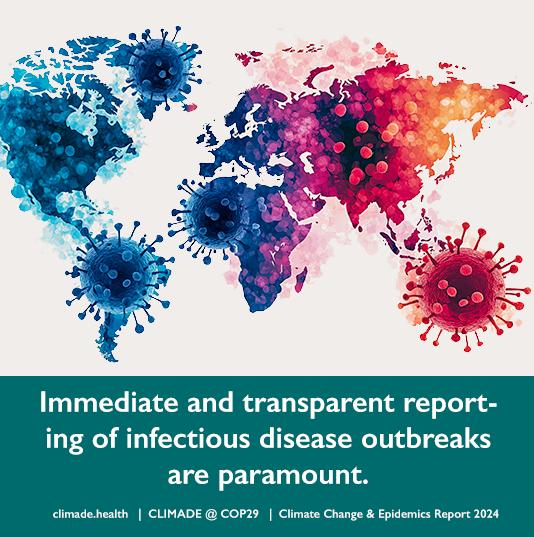

Early detection of an outbreak can help to guide the response and reduce the spread of diseases
James Ayei Maror National Public Health Laboratory, South Sudan
Call to Action 1: Report Outbreaks timeously
Immediate and transparent reporting of infectious disease outbreaks is paramount. Governments and health organizations should commit to reporting outbreaks promptly and openly, sharing crucial data with relevant stakeholders. This transparency is essential for global preparedness and response efforts.
Call for Action 2: Strengthen Genomic Surveillance
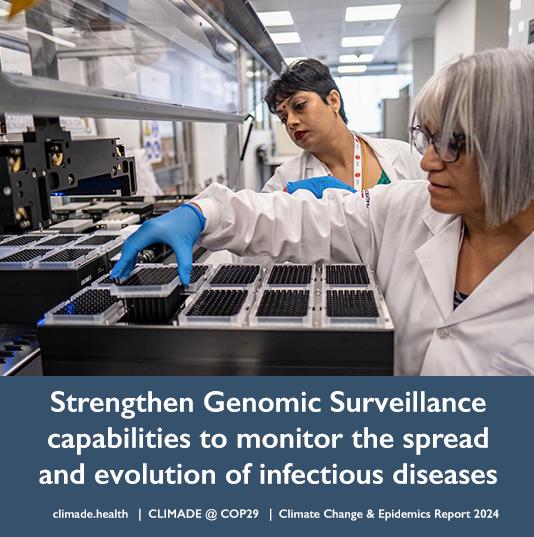

The monitoring of pathogenic agents through the study of their behaviour in the face of climate change will make it possible to anticipate actions to prevent epidemics.
Jerome National Institute of Public Health, Burundi
Call to Action 2: Strengthen Genomic Surveillance
Governments, academic institutions, and health organizations must invest in and expand genomic surveillance capabilities to monitor the spread and evolution of infectious diseases. This will enable early detection and response to emerging threats, allowing us to prevent outbreaks before they escalate.
Nkuurunziza
Call for Action 3: Prioritize Vulnerable Populations
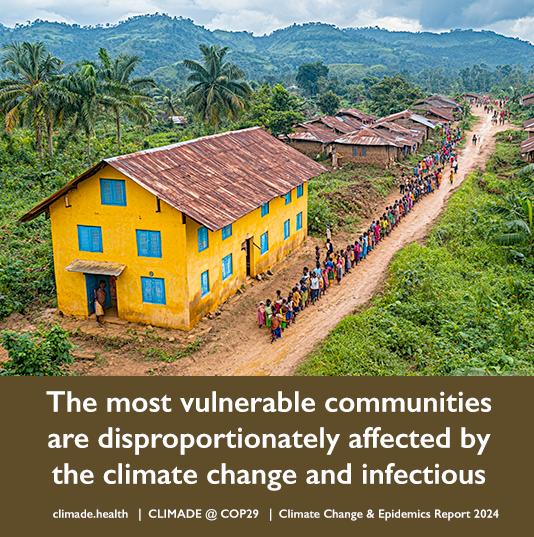

Climate change, infectious diseases and outbreaks/ epidemics in Uganda are closely intertwined and can result in long-lasting socioeconomic effects such as a weakened and less productive workforce s
Aloysious Ssemaganda
Uganda - National Health Laboratories and Diagnostic Services
Call to Action 3: Prioritize Vulnerable Populations
The most vulnerable communities are disproportionately affected by the intersection of climate change and infectious diseases. Governments and private sector industries must prioritize these populations by investing in resilient healthcare systems, infrastructure, and disaster preparedness measures.
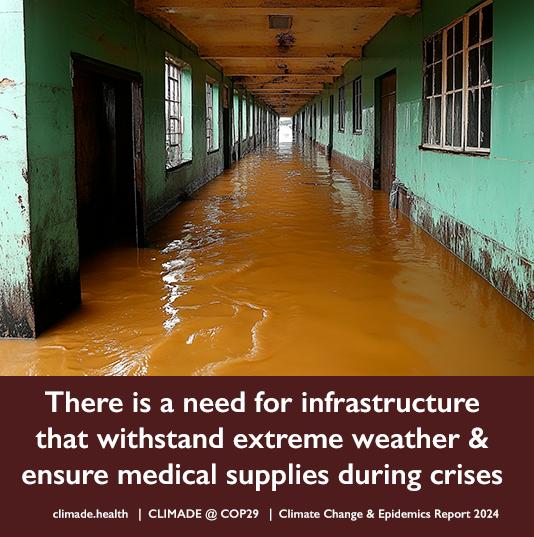

Climate resilience helps combat disease outbreaks by enhancing a community's ability to adapt and respond to changing conditions. Resilient systems can withstand and recover from climate-related challenges, reducing vulnerabilities that could otherwise facilitate disease transmission.
Yameen Badrodien University of Cape Town, South Africa
Call to Action 4: Promote Climate Resilience
Academic institutions and private sector industries should collaborate to develop innovative solutions that enhance climate resilience within healthcare systems. This includes designing infrastructure to withstand extreme weather events and ensuring the availability of essential medical supplies during crises.
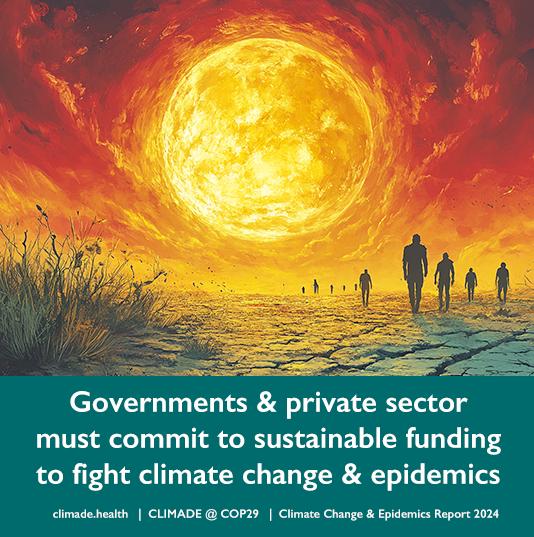

The biggest challenge is the high technical and financial costs of genomic surveillance, need to train bioinformaticians in Africa, need to develop more user-friendly pipeline for genomic data analysis
Call to Action 5: Commit Sustainable Funding
Governments, private sector industries, and health organizations must commit to sustainable funding dedicated to the fight against climate change-related infectious diseases. This funding should support research, capacity-building, and community engagement to create a robust defense against these converging threats.
Joseph Fokam Cameroon

Acknowledgements
CLIMADE is a global programme that is led by Global South with European, American and Oceania partners. Initial funding for the CLIMADE initiative is gratefully acknowledged. CLIMADE and CERI wishes to express its gratitude to the following funders for their generous support: The Rockefeller Foundation, the Technology Innovation Agency (TIA) of the Department of Science and Innovation (DSI), South African Medical Research Council (SAMRC), European Commission (EC) and the National Institute of Health, Abbott, Africa CDC, WHO AFRO and the World Bank. The report is published as open access under a Creative Commons ShareAlike 30 Unported (CC BY-SA 30) license (T. de Oliveira and C. Baxter (eds)]. CLIMADE, Stellenbosch, South Africa. pp132, https://climade.health/climade-cop29-report/) and is available in printed format as well as electronically as PDF, Web-format, etc. The contents of this report and the opinions expressed herein are solely the responsibility of the authors and do not necessarily represent the official views or policies of any of the funders.
For more information about this report on the CLIMADE website:

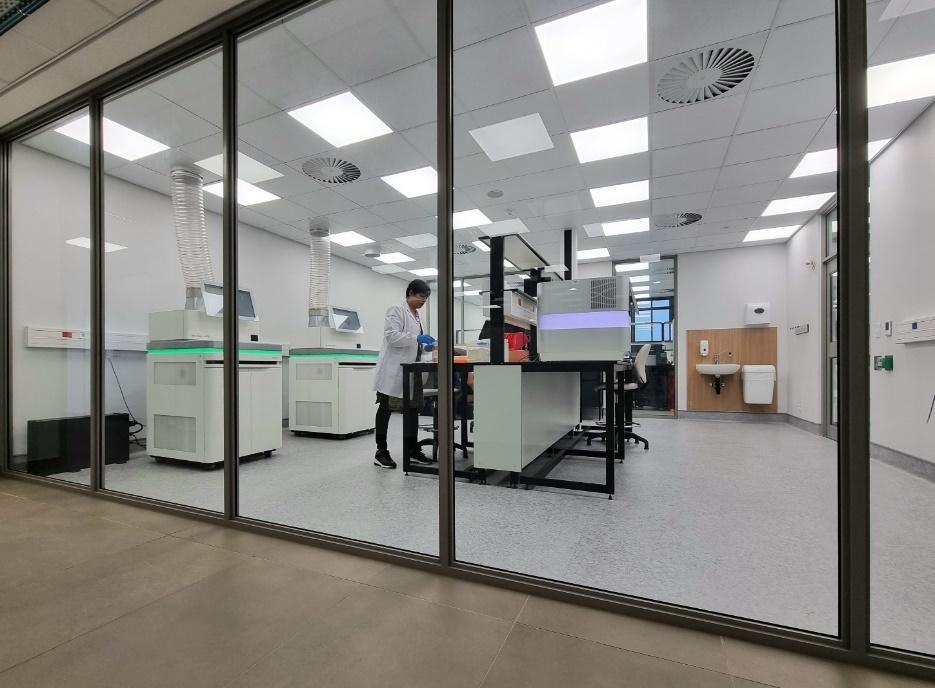

ceri@sun.ac.za

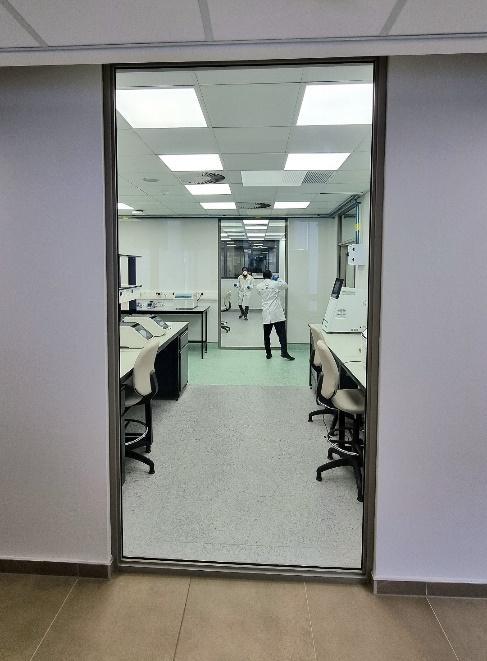
CLIMADE Secretariat, Centre for Epidemic Response and Innovation (CERI), Level 3, Biomedical Research Institute (BMRI) Building, Tygerberg Medical School Campus, Stellenbosch University, Francie Van Zijl Dr,
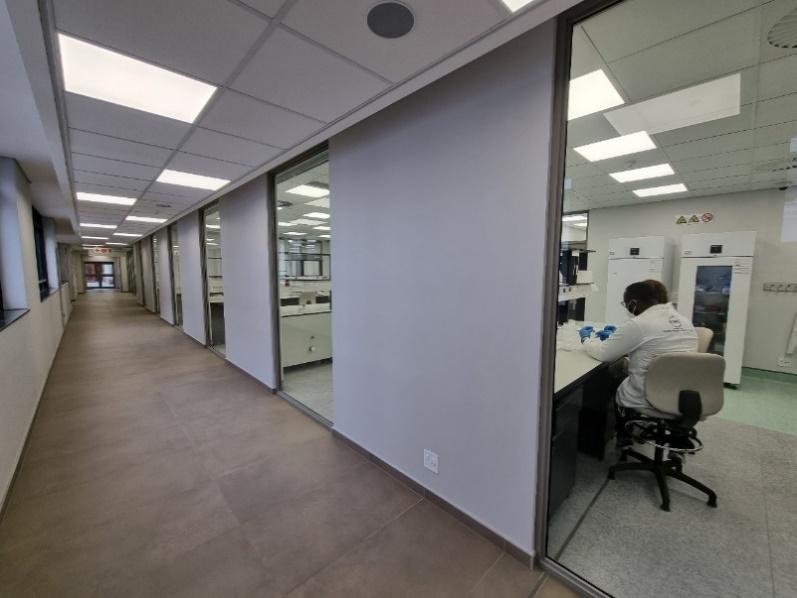
https://climade.health/

https://twitter.com/climade_health
2023-2024 List of publications
1. Giovanetti M, Vazquez C, Lima M, Castro E, Rojas A, Gomez de la Fuente A, Aquino C, Cantero C, Fleitas F, Torales J, Barrios J, Ortega MJ, Gamarra ML, Villalba S, Alfonzo T, Xavier J, Adelino T, Fritsch H, Iani FCM, Pereira GC, de Oliveira C, Schuab G, Rodrigues ES, Kashima S, Leite J, Gresh L, Franco L, Tegally H, Van Voorhis WC, Lessels R, de Filippis AMB, Ojeda A, Sequera G, Montoya R, Holmes EC, de Oliveira T, Rico JM, Lourenço J, Fonseca V, Alcantara LCJ. Rapid Epidemic Expansion of Chikungunya Virus East/Central/South African Lineage, Paraguay Emerging Infectious Diseases 2023; 29(9):1859-1863.
2. Tegally H, Wilkinson E, Tsui JL, Moir M, Martin D, Brito AF, Giovanetti M, Khan K, Huber C, Bogoch II, San JE, Poongavanan J, Xavier JS, Candido DDS, Romero F, Baxter C, Pybus OG, Lessells RJ, Faria NR, Kraemer MUG, de Oliveira T. Dispersal patterns and influence of air travel during the global expansion of SARSCoV-2 variants of concern. Cell 2023;186(15):3277-3290.e16. doi: 10.1016/j.cell.2023.06.001.
3. Tsui JL, McCrone JT, Lambert B, Bajaj S, Inward RPD, Bosetti P, Pena RE, Tegally H, Hill V, Zarebski AE, Peacock TP, Liu L, Wu N, Davis M, Bogoch II, Khan K, Kall M, Abdul Aziz NIB, Colquhoun R, O'Toole Á, Jackson B, Dasgupta A, Wilkinson E, de Oliveira T; COVID-19 Genomics UK (COG-UK) consortium¶; Connor TR, Loman NJ, Colizza V, Fraser C, Volz E, Ji X, Gutierrez B, Chand M, Dellicour S, Cauchemez S, Raghwani J, Suchard MA, Lemey P, Rambaut A, Pybus OG, Kraemer MUG. Genomic assessment of invasion dynamics of SARS-CoV-2 Omicron BA.1 Science 2023; 381(6655):336-343. doi: 10.1126/science.adg6605.
4. Francisco NM, van Wyk S, Moir M, San JE, Sebastião CS, Tegally H, Xavier J, Maharaj A, Neto Z, Afonso P, Jandondo D, Paixão J, Miranda J, David K, Inglês L, Pereira A, Paulo A, Carralero RR, Freitas HR, Mufinda F, Lutucuta S, Ghafari M, Giovanetti M, Giandhari J, Pillay S, Naidoo Y, Singh L, Tshiabuila D, Martin DP, Chabuka L, Choga W, Wanjohi D, Mwangi S, Pillay Y, Kebede Y, Shumba E, Ondoa P, Baxter C, Wilkinson E, Tessema SK, Katzourakis A, Lessells R, de Oliveira T, Morais J. Insights into SARS-CoV-2 in Angola during the COVID-19 peak: Molecular epidemiology and genome surveillance Influenza Other Respir Viruses 2023;17(9):e13198. doi: 10.1111/irv.13198.
5. Oguzie JU, Petros BA, Oluniyi PE, Mehta SB, Eromon PE, Nair P, Fasoro OA, Ifoga PD, Odia I, Pastusiak A, Gbemisola OS, Aiyepada JO, Uyigue EA, Edamhande AP, Blessing O, Airende M, Tomkins-Tinch C, Qu J, Stenson L, Schaffner SF, Oyejide N, Ajayi NA, Ojide K, Ogah O, . . . ., Happi CT. Metagenomic surveillance uncovers diverse and novel viral taxa in febrile patients from Nigeria. Nature Communications 2023; 14 (4693): DOI: 10.1038/s41467-023-40247-4
6. Ramphal U, Tshiabuila D, Ramphal Y, Giandhari J, van Heerden C, Baxter C, van Wyk S, Pillay S, LagudaAkingba O, Wilkinson E, Lessells R, de Oliveira T. Reflective Evaluation of Next-Generation Sequencing Data during Early Phase Detection of the Delta Variant OBM Genetics 2024; 8(2): 239; doi:10.21926/obm.genet.2402239.
7. Ramphal Y, Tegally H, San JE, Reichmuth ML, Hofstra M, Wilkinson E, Baxter C, CLIMADE Consortium, de Oliveira T, Moir M. Understanding the Transmission Dynamics of the Chikungunya Virus in Africa Pathogens 2024; 13(7):605. doi: 10.3390/pathogens13070605.
8. Tsui JLH, Pena RE, Moir M, Inward RPD, Wilkinson E, San JE, Poongavanan J, Bajaj S, Gutierrez B, Dasgupta A, de Oliveira T, Kraemer MUG, Tegally H, Sambaturu P. Impacts of climate change-related human migration on infectious diseases Nat. Clim. Chang 2024; 14, 793–802. https://doi.org/10.1038/s41558-024-02078-z
9. Teresa Nazareth, Gonçalo Seixas, José Lourenço, Paulo J. G. Bettencourt. Aedes albopictus arrives in Lisbon: an emerging public health threat Front. Public Health 2023; 11: doi.org/10.3389/fpubh.2023.1332334
10. Marta Giovanetti, Eleonora Cella, Sonia Moretti, Fabio Scarpa, Alessandra Ciccozzi, Svetoslav Nanev Slavov, Francesca Benedetti, Davide Zella, Giancarlo Ceccarelli, Massimo Ciccozzi, Alessandra Borsetti. Monitoring Monkeypox: Safeguarding Global Health through Rapid Response and Global Surveillance Pathogens 2023, 12, 1153. https://doi.org/10.3390/pathogens12091153
11. Francesco Branda, Fabio Scarpa, Chiara Romano, Alessandra Ciccozzi, Antonello Maruotti, Marta Giovanetti, Massimo Ciccozzi. Chikungunya vaccine: Is it time for it? J Med Virol 2023; 95(12):e29341. doi: 10.1002/jmv.29341.
12. Cynthia Vazquez, Vagner Fonseca, Andrea Gomez de la Fuente, Sandra Gonzalez, Fatima Fleitas, Mauricio Lima, Natália R. Guimarães, Felipe C. M. Iani, Analia Rojas, Tania Alfonso, Cesar Cantero, Julio Barrios, Shirley Villalba, Maria Jose Ortega, Juan Torales, Maria Liz Gamarra, Carolina Aquino, Leticia Franco, Jairo Mendez Rico, Luiz Carlos Junior Alcantara, Marta Giovanetti. Exploring the Genomic Dynamics of the Monkeypox Epidemic in Paraguay. Viruses 2024; 16(1):83. doi: 10.3390/v16010083.
13. Noelia Morel, Marta Giovanetti, Vagner Fonseca, Analía Burgueño, Mauricio Lima, Emerson Castro, Natália R. Guimarães, Felipe C. M. Iani, Victoria Bormida, Maria Noel Cortinas, Viviana Ramas, Leticia Coppola, Ana I. Bento, Alexander Rosewell, Leticia Franco, Jairo Mendez Rico, José Lourenço, Luiz Carlos Junior Alcantara, Hector Chiparelli. Genomics-based timely detection of Dengue Virus type I genotypes I and V in Uruguay medRxiv [Preprint]. 2023: doi: 10.1101/2023.09.05.23295075.
14. Joilson Xavier, Vagner Fonseca, Talita Adelino, Felipe C. M. Iani, Glauco C. Pereira, Myrian M. Duarte, Mauricio Lima, Emerson Castro, Carla Oliveira, Hegger Fritsch, Natalia Guimarães, Ludmila O. Lamounier, Fernanda Khouri Barreto, Camilo M. M. Braga de Oliveira, Crhistinne C. Maymone Gonçalves, Danielle Malta Lima, Elaine C. de Oliveira, Gislene G. de Castro Lichs, Iago Gomes, Janaina Mazaro, Janete T. N. Rodrigues, Jayra Abrantes, Jeová K. B. Colares, Kleber G. Luz, Luana Barbosa da Silva, Luiz Demarchi, Magaly C. B. Câmara, Marina C. S. Umaki Zardin, Rafaela Sabatini Mello Pinheiro, Rutilene Barbosa Souza, Simone K. Haddad, Stephanni Figueiredo da Silva, Svetoslav N. Slavov, Themis Rocha, Noelia Morel, Hector Chiparelli, Analía Burgueño, Victoria Bórmida, María N. Cortinas, Rosario S. Martín, Allan C. Pereira, Marcelo F. dos Santos, Walter André Júnior, Jairo Mendez Rico, Leticia Franco, Alexander Rosewell, Rodrigo F. do Carmo Said, Carlos F. C. de Albuquerque, Ethel L. Noia Maciel, Marília Santini de Oliveira, Rivaldo Venâncio da Cunha, Livia C. Vinhal Frutuoso, Ana M. B. de Filippis, Marta Giovanetti, Luiz Carlos Junior Alcantara. A Multiplex Nanopore Sequencing Approach for the Detection of Multiple Arboviral Species. Viruses 2023; 16(1):23. doi: 10.3390/v16010023.
15. Isaac Miguel, Edwin P. Feliz, Robinson Agramonte, Pedro V. Martinez, Carlos Vergara, Yvonne Imbert, Lucia De la Cruz, Nurys de Castro, Odalis Cedano, Yamilka De la Paz, Vagner Fonseca, Gilberto A. Santiago, Jorge L. Muñoz-Jordán, Armando Peguero, Robert Paulino-Ramírez, Nathan D. Grubaugh, Ana Maria Bispo de Filippis, Luiz Carlos Junior Alcantara, Jairo Mendez Rico, José Lourenço, Leticia Franco, Marta Giovanetti. North-south pathways, emerging variants, and high climate suitability characterize the recent spread of dengue virus serotypes 2 and 3 in the Dominican Republic. BMC Infect Dis. 2024; 24(1):751. doi: 10.1186/s12879-024-09658-6.
16. Analía Burgueño, Marta Giovanetti, Vagner Fonseca, Noelia Morel, Mauricio Lima, Emerson Castro, Natália R. Guimarães, Felipe C. M. Iani, Victoria Bormida, Maria Noel Cortinas, Viviana Ramas, Leticia Coppola, Ana I. Bento, Leticia Franco, Jairo Mendez Rico, José Lourenço, Luiz Carlos Junior Alcantara, Hector Chiparelli. Genomic and eco-epidemiological investigations in Uruguay reveal local Chikungunya virus transmission dynamics during its expansion across the Americas in 2023 Emerg Microbes Infect 2024; 13(1):2332672. doi: 10.1080/22221751.2024.2332672. Epub 2024 Apr 15.
17. Francesco Branda, Chiara Romano, Massimo Ciccozzi, Marta Giovanetti, Fabio Scarpa, Alessandra Ciccozzi, Antonello Maruotti. Mpox: An Overview of Pathogenesis, Diagnosis, and Public Health Implications. J. Clin. Med. 2024, 13(8), 2234; https://doi.org/10.3390/jcm13082234
18. Francesco Branda, Marta Giovanetti, Chiara Romano, Domenico Benvenuto, Alessandra Ciccozzi, Daria Sanna, Massimo Ciccozzi, Fabio Scarpa. Global Measles Surveillance: Trends, Challenges, and Implications for Public Health Interventions Infect Dis Rep. 2024;16(2):367-379. doi: 10.3390/idr16020028.
19. Debora Glenda Lima de La Roque, Elaine Vieira Santos, Lucca Rocha Policastro, Péricles Natan Mendes da Costa, Mariane Evaristo, Aparecida Yulie Yamamoto, Denise Bergamaschi Giomo, Paula Marilia Afonso Torres, Danielle Cristina Dacanal Gentil, Elaine Cristina Manini Minto, Svetoslav Nanev Slavov, Vagner Fonseca, Claudia Renata dos Santos Barros, Antonio Jorge Martins, Rodrigo Tocantins Calado, Luzia Márcia Romanholi Passos, Maria Carolina Elias, Sandra Coccuzzo Sampaio, Marta Giovanetti, Dimas Tadeu Covas, Luiz Carlos Júnior Alcântara, Simone Kashima. Exploring the Chikungunya virus landscape in a dengue-endemic Brazilian area. J Infect Public Health. 2024;17(7):102442. doi: 10.1016/j.jiph.2024.04.026. Epub 2024 May 15.
20. Felipe Campos de Melo Iani, Gabriel Montenegro de Campos, Talita Emile Ribeiro Adelino, Anielly Sarana da Silva, Simone Kashima, Luiz Carlos Junior Alcantara, Sandra Coccuzzo Sampaio, Marta Giovanetti, Maria Carolina Elias, Svetoslav Nanev Slavov. Metagenomic Analysis for Diagnosis of Hemorrhagic Fever in Minas Gerais, Brazil Microorganisms 2024; 12(4):769. doi: 10.3390/microorganisms12040769.
21. Cintia Fabbri, Marta Giovanetti, Victoria Luppo, Vagner Fonseca, Jorge Garcia, Cintia Barulli, Mariel Feroci, Sofia Perrone, Doraldina Casoni, Sergio Giamperetti, Maria Cristina Alvarez Lopez, Maria Delia Foussal, Mauricio Figueredo, Karina Salvatierra, Sergio Lejona, Natalia Ruiz Diaz, Gonzalo Castro, Gabriela Bravo, Noelia Jackel, Carina Sen, Tomás Poklepovich Caride, Leticia Franco, Carlos Giovachini, Jairo Mendez Rico, Luiz Carlos Junior Alcantara, Maria Alejandra Morales. Tracing the evolution of the chikungunya virus in Argentina, 2016-2023: independent introductions and prominence of Latin American lineages Emerg Microbes Infect 2024;13(1):2362941. doi: 10.1080/22221751.2024.2362941.
22. Gabriel Schuab, Stephane Tosta, Keldenn Moreno, Vagner Fonseca, Luciane Amorim Santos, Svetoslav Nanev Slavov, Simone Kashima, Massimo Ciccozzi, José Lourenço, Eleonora Cella, Carla de Oliveira, Andréa Cony Cavalcanti, Luiz Carlos Junior Alcantara, Fernanda de Bruycker-Nogueira, Ana Maria Bispo de Filippis, Marta Giovanetti. Exploring the urban arbovirus landscape in Rio de Janeiro, Brazil: transmission dynamics and patterns of disease spread Lancet Reg Health Am. 2024;35:100786. doi: 10.1016/j.lana.2024.100786
23. Martim A. Geraldes, Mónica V. Cunha, Carlos Godinho, Ricardo F. de Lima, Marta Giovanetti, José Lourenço. The historical ecological background of West Nile virus in Portugal indicates One Health opportunities. Sci Total Environ 2024:944:173875. doi: 10.1016/j.scitotenv.2024.173875.
24. Talita Adelino, Maurício Lima, Natália R. Guimarães, Joilson Xavier, Vagner Fonseca, Luiz Marcelo R. Tomé, Maira Alves Pereira, Vanessa Ferreira Machado, Luiz Carlos Junior Alcantara, Felipe C. de Melo Iani, Marta Giovanetti. Resurgence of Dengue Virus Serotype 3 in Minas Gerais, Brazil: A Case Report. Pathogens 2024;13(3):202. doi: 10.3390/pathogens13030202.
25. de Oliveira T, Tegally H. Will climate change amplify epidemics and give rise to pandemics? Science. 2023 ; 381(6660):eadk4500. doi: 10.1126/science.adk4500.
26. Carlson C, Becker D, Happi C, O'Donoghue Z, de Oliveira T, Oyola SO, Poisot T, Seifert S, Phelan A. Save lives in the next pandemic: ensure vaccine equity now Nature 2024; 626(8001):952-953. doi: 10.1038/d41586-024-00545-3
27. Mavian CN, Tagliamonte MS, Alam MT, Sakib SN, Cash MN, Moir M, Jimenez JP, Riva A, Nelson EJ, Cato ET, Ajayakumar J, Louis R, Curtis A, De Rochars VMB, Rouzier V, Pape JW, de Oliveira T, Morris JG Jr, Salemi M, Ali A. Ancestral Origin and Dissemination Dynamics of Reemerging Toxigenic Vibrio cholerae, Haiti Emerging Infectious Diseases 2023; 29(10):2072-2082. doi: 10.3201/eid2910.230554.
28. Ulaeto D, Agafonov A, Burchfield J, Carter L, Happi C, Jakob R, Krpelanov E, Kuppalli K, Lefkowitz E, Mauldin M, de Oliveira T, Onoja B, Otieno J, Rambaut A, Subissi L, Yinka-Ogunleye A, Lewis RF. New nomenclature for mpox (monkeypox) and monkeypox virus clades The Lancet Infectious Diseases 2023; 23(3):273–275.
29. Anoh EA, Wayoro O, Monemo P, Belarbi E, Sachse A, Wilkinson E, San JE, Leendertz FH, Diané B, Calvignac-Spencer S, Akoua-Koffi C, Schubert G. Subregional origins of emerging SARS-CoV-2 variants during the second pandemic wave in Côte d'Ivoire Virus Genes 2023;59(3):370-376. doi: 10.1007/s11262-023-01984-2.
30. Giovanetti M, Vazquez C, Lima M, Castro E, Rojas A, Gomez de la Fuente A, Aquino C, Cantero C, Fleitas F, Torales J, Barrios J, Ortega MJ, Gamarra ML, Villalba S, Alfonzo T, Xavier J, Adelino T, Fritsch H, Iani FCM, Pereira GC, de Oliveira C, Schuab G, Rodrigues ES, Kashima S, Leite J, Gresh L, Franco L, Tegally H, Van Voorhis WC, Lessels R, de Filippis AMB, Ojeda A, Sequera G, Montoya R, Holmes EC, de Oliveira T, Rico JM, Lourenço J, Fonseca V, Alcantara LCJ. Rapid Epidemic Expansion of Chikungunya Virus East/Central/South African Lineage, Paraguay Emerging Infectious Diseases 2023; 29(9):1859-1863. doi: 10.3201/eid2909.230523
31. Giovanetti M, Pinotti F, Zanluca C, Fonseca V, Nakase T, Koishi AC, Tscha M, Soares G, Dorl GG, Marques AEML, Sousa R, Adelino TER, Xavier J, de Oliveira C, Patroca S, Guimaraes NR, Fritsch H, Mares-Guia MA, Levy F, Passos PH, da Silva VL, Pereira LA, Mendonça AF, de Macêdo IL, Ribeiro de Sousa DE, Rodrigues de Toledo Costa G, Botelho de Castro M, de Souza Andrade M, de Abreu FVS, Campos FS, Iani FCM, Pereira MA, Cavalcante KRLJ, de Freitas ARR, Campelo de Albuquerque CF, Macário EM, Dos Anjos MPD, Ramos RC, Campos AAS, Pinter A, Chame M, Abdalla L, Riediger IN, Ribeiro SP, Bento AI, de Oliveira T, Freitas C, Oliveira de Moura NF, Fabri A, Dos Santos Rodrigues CD, Dos Santos CC, Barreto de Almeida MA, Dos Santos E, Cardoso J, Augusto DA, Krempser E, Mucci LF, Gatti RR, Cardoso SF, Fuck JAB, Lopes MGD, Belmonte IL, Mayoral Pedroso da Silva G, Soares MRF, de Castilhos MMS, de Souza E Silva JC, Bisetto Junior A, Pouzato EG, Tanabe LS, Arita DA, Matsuo R, Dos Santos Raymundo J, Silva PCL, Santana Araújo Ferreira Silva A, Samila S, Carvalho G, Stabeli R, Navegantes W, Moreira LA, Ferreira AGA, Pinheiro GG, Nunes BTD, de Almeida Medeiros DB, Cruz ACR, Venâncio da Cunha R, Van Voorhis W, Bispo de Filippis AM, Almiron M, Holmes EC, Ramos DG, Romano A, Lourenço J, Alcantara LCJ, Duarte Dos Santos CN. Genomic epidemiology unveils the dynamics and spatial corridor behind the Yellow Fever virus outbreak in Southern Brazil. Science Advances 2023; 9(35):eadg9204. doi: 10.1126/sciadv.adg9204.
32. Nachega JB, Sam-Agudu NA, Ogoina D, Mbala-Kingebeni P, Ntoumi F, Nakouné E, Njouom R, Lewis RF, Gandhi M, Rosenthal PJ, Rawat A, Wilson LA, Kindrachuk J, Liesenborghs L, Mills EJ, Preiser W, Rimoin AW, Sullivan NJ, Peeters M, Delaporte E, Baxter C, Harrison L, Hermans MP, Mohr EL, Gonsalves G, Ndembi N, Zumla A, Muyembe-Tamfum JJ; Mpox Research Consortium. The surge of mpox in Africa: a call for action Lancet Global Health 2024; 12(7):e1086-e1088. doi: 10.1016/S2214-109X(24)00187-6.
CLIMADE ACTIVITIES
CLIMADE Africa
Weekly CLIMADE-Africa working group meetings
Monika Moir (South Africa), Tulio de Oliveira (South Africa), Houriiyah Tegally (South Africa), John Juma (Kenya)
Regular online seminars and training sessions hosted with CLIMADE Africa Consortium and contributions from CLIMADE Europe and CLIMADE Latin America. Topic covered thus far in the meetings include:
● The landscape of prevalence and surveillance of climate sensitive vector-borne diseases in Africa
● Genomic monitoring of arboviruses in South America
● Details for drawing up a Material Transfer Agreement with the regional laboratories in Africa (CERI, ACEGID, and ILRI)
● Preliminary phylogenetics and transmission dynamics for arboviruses in Africa
● Progress report on the prevalence and surveillance of climate sensitive vector-borne diseases in Africa,
● Genomic classification for Rift Valley Fever Virus
● Cholera introduction and spread across the African continent
● Tutorial on the use of Rift Valley Fever Virus typing tools on web-based Genome Detective and command line based Nextflow language
● Adapting the protocol for Cholera whole genome sequencing during the Malawi epidemic
● Pipelines for viruses: Bioinformatic analysis and viral typing tools
● Workflow for Genomic Analysis of Vibrio Cholera: Application for recent outbreak
● Second Quarter CLIMADE progress report
● The contribution of climate to the global transmission potential of the dengue virus
● Assessing the current and future gaps of dengue genomic surveillance in Africa
● Dengue transmission risk areas and enhancing surveillance data systems from climate-sensitive diseases in Africa
● Continued discussion of dengue transmission risk areas and enhancing surveillance data systems from climate-sensitive diseases in Africa - with a focus on data sources
● Understanding the persistence vs introductions of dengue in Africa
● Third Quarter CLIMADE progress report
● Master protocols and preparedness through pivoting of integrated genomic surveillance for public health response
● Translation of modelling outputs for maximum impact of the public health response
● Integrated data analytics for arbovirus risk assessment
● Implementing an integrated system to enhance the surveillance of emerging and reemerging viral threats across the Americas
Genomic and Ecological characterization of Dengue circulation in West Africa
Souleymane Mboup (Senegal), Abdou Padane (Senegal), Tulio de Oliveira (South Africa), Houriiyah Tegally (South Africa), Monika Moir (South Africa), Jenicca Poongavanan (South Africa), Graeme Dor (South Africa)
Unlike other parts of Africa which seem to suffer from Dengue outbreaks following regular re-introductions from Asia, it is clear that circulation of Dengue in West Africa may rather be maintained endemically. During the first half of 2023, we engaged with public health offices in various countries who stressed the need for serological and genomic characterization of non-malaria febrile cases in West Africa. Genomic information on the circulation of Dengue had so far been limited, often emanating from testing of returning travelers to Europe. CLIMADE therefore organized and mobilised reagents for the sequencing of 300 Dengue positive cases sampled from 2017 to 2022. Preliminary results indicate the co-circulation of 3 Dengue serotypes in West Africa (DENV1,2,3), with viral movement between densely populated urban areas of the region over several years. Preliminary evidence suggests that large outbreaks in 2017 and 2019 were caused by explosive growth of the DENV2 serotype after cryptic low level circulation for decades, while other serotypes remained stable. Further sampling, sequencing and analysis are ongoing to confirm these conclusions.
Genomic characterization of Chikungunya outbreaks in Coastal Kenya
Sam Oyola (Kenya), John Juma (Kenya), Tulio de Oliveira (South Africa), Houriiyah Tegally (South Africa), Yajna Ramphal (South Africa), Marta Giovanetti (Brazil), Jose Lourenco (Portugal), Luiz Alcantara (Brazil)
Outbreaks of chikungunya virus have been recorded in Kenya since the 1970s with perhaps the most devastating occurring on the coastal island of Lamu in 2004. Chikungunya virus is considered as endemic in coastal Kenya with a 0.7% prevalence in asymptomatic children and common recurrent infections. Under this project, 43 serum samples were retrieved from patients suspected of suffering arboviral infections. These specimens were sequenced with the generation of 28 complete chikungunya viral genomes. These genomes, in context with all other publicly available genomes from Africa, are analysed within a phylogenetic and phylogeographic framework to understand the evolution, direction of spread, and speed of spread of chikungunya across the African continent.
Assessing the current and future gaps in Dengue genomic surveillance in Africa in the face of climate change and human mobility
Houriiyah Tegally (South Africa), Jenicca Poongavanan (South Africa), Monika Moir (South Africa), Moritz U.G. Kraemer (Oxford), Tulio de Oliveira (South Africa)
This project will contribute to risk assessment for Dengue circulation and outbreaks in Africa by developing a conceptual and methodological framework to integrate climatic, mobility and population covariates within genomic epidemiology with the following goals: 1) Research towards arboviruses (e.g. Dengue) in Africa are limited and when they exist, are restricted to small
local outbreak investigations. This project aims to take a continental approach to investigate risks of importations of Dengue from Asia and Latin-America, cross-border transmission in Africa and uncover patterns linked to climate events and human mobility; 2) Rather than analyzing genomic, epidemiological or climatic data in silos, like is often the case in infectious disease research, this proposal aims to employ integrative data analysis approaches with genomic epidemiology, phylodynamics and climatic modeling approaches; 3) Assess the likelihood of endemic circulation vs re-introductions of Dengue in Africa and consequently pinpoint the current and future gaps in genomic surveillance to guide upcoming efforts to scale up sequencing.
Genomic characterization of deadly Cholera in Malawi following severe flooding events
Lucious Chabuka (Malawi), Tulio de Oliveira (South Africa)
Since early 2022, in the aftermath of two extreme weather events, Malawi experienced its largest ever cholera outbreak, with over 58,000 reported cases and 1,761 deaths as of May 2023. We generated 49 high-quality, near-complete Vibrio cholerae genomes in Malawi from isolates collected between December 2022 and March 2023 from all three regions of Malawi. Using phylogenetic methods with 2159 publicly available genomes, we present evidence suggesting that the Malawi outbreak strains originated from the Pakistan outbreak, the estimated most recent ancestor of this lineage, named T15, was during the Pakistan floods, and once introduced into Malawi was exacerbated by major floods between June and October 2022. The extreme weather events and humanitarian crises in Malawi provided the environment for the spread of Vibrio cholerae, and the subsequent movement of large numbers of people may have facilitated its spread to susceptible populations in areas relatively unaffected by cholera for over a decade.
Expert Voices Column in Science Magazine - “Will climate change amplify epidemics and give rise to pandemics?”
Houriiyah Tegally (South Africa), Tulio de Oliveira (South Africa)
We were invited to participate in this new monthly column in Science Magazine. We decided to write and publish a short piece as a call for action towards the dangers of climate change and epidemics. Engagement on the piece has been very large showing the interest that the general community holds towards this pressing issue. The aim of this exercise was to raise awareness, which is as important an activity to engage in as research for scientists.
Climate change and infectious diseases module development for 28th VEME (Viral Evolution and Molecular Epidemiology workshop) 2024
Houriiyah Tegally (South Africa), Jenicca Poongavanan (South Africa)
Researchers in the CLIMADE consortium have spent years, and even decades, training the next generation of virus genomic epidemiologists, many of whom have been critical in our collective response to the pandemic and during other viral epidemics. As the world now faces increasing threats of the intersection between climate change and epidemics, it is critical to equip upcoming scientists with the necessary skills to research this topic. As such, we are developing a short course of advanced analysis of climate change and infectious disease dynamics for the VEME workshop for 2024, which will be a first for this workshop. This short module will involve extracting and visualizing environmental raster files, spatiotemporal regressions of large climatic and epidemiological datasets, and integration of environmental parameters into phylodynamic analyses. This new short module will complement perfectly the other workshop streams at VEME, focused on genomic, phylogenetics and epidemiological analysis of viral pathogens.
Continent-wide survey to assess the landscape of prevalence and surveillance of arboviruses in Africa
Monika Moir (South Africa)
A detailed questionnaire was designed to understand what arboviral outbreaks are occurring in Africa, where they are occurring, what genomic surveillance programs have been conducted during these outbreaks and the extent of surveillance capacity currently available in Africa. We received responses from 64 individuals representing public health laboratories, academic institutions and non-profit research centres from 34 African countries. The results of this study will allow us to identify geographical hotspots for arboviral outbreaks and capacity cold spots for genomic surveillance of these neglected diseases. Through this survey we are understanding the barriers faced by institutions in sequencing these viruses, which likely extends to many other pathogens, but also the successes from their regional programs fighting these diseases.
CLIMADE Europe
The ecological backgrounds of historical West Nile virus transmission in Portugal
Martim Geraldes (Portugal), Mónica Vieira Cunha (Portugal), José Lourenço (Portugal)
There is historical evidence for West Nile virus (WNV) transmission since 1979 in Portugal. However, to date, only four human infections and sporadic infections in equids have been detected. WNV is now endemic in most of the Mediterranean Basin with yearly epidemic activity in humans and equids. Informed by a large number of ecological and climate variables, machine learning approaches are being developed to unravel and characterize the ecological backgrounds matching historical evidence of WNV transmission in Portugal.
Estimating suitable ecological backgrounds for West Nile virus on the island of São Tomé
Martim Geraldes (Portugal), Mónica Vieira Cunha (Portugal), José Lourenço (Portugal)
There is no evidence for West Nile virus (WNV) transmission on the island of São Tomé, although it is generally accepted that local ecological conditions are favourable. Transferring knowledge generated from another activity in the context of Portugal, machine learning approaches are being used to identify the ecological backgrounds (areas) of the island likely suitable for WNV transmission. The overarching goal is to identify where and when targeted surveillance of mosquitos, birds and humans should be deployed to demonstrate presence or absence of WNV on the island.
Historical climate-stress on dengue virus transmission potential across the globe
Taishi Nakase (USA), Uri Obolski (Israel), Marta Giovanetti (Italy), José Lourenço (Portugal), Túlio Oliveira (South Africa)
Recently we generated and made available a large dataset holding climate-driven estimations of dengue virus (DENV) transmission potential for the period 1979 to 2019 across the globe with high spatial resolution. Resorting to several statistical, time series approaches, we are now quantifying how much DENV transmission potential has decreased or increased due to climate-change trends between 1979 to 2019. Areas of the globe where climate has stressed transmission potential will be identified.
Historical climate-stress on West Nile virus transmission potential in Portugal
Martim Geraldes (Portugal), Mónica Vieira Cunha (Portugal), Uri Obolski (Israel), José Lourenço (Portugal)
Transferring knowledge from another activity where the suitable ecological backgrounds for West Nile virus (WNV) in Portugal have been identified and characterized, we are retrospectively (and prospectively) assessing what the contribution of climate change has been (and will be) in decreasing or increasing WNV transmission potential in Portugal.
Natural climate variation predicts Aedes aegypti population dynamics
Tarek Alrefae (UK), Uri Obolski (Israel), José Lourenço (Portugal)
Over the last 5 years we have been successful at developing modelling tools that can predict the spatio-temporal transmission activity of a variety of mosquito-borne pathogens. So far, we have neglected local mosquito population dynamics, with open questions still standing on how natural climate variation dictates spatio-temporal abundance and presence of key mosquito species. We are developing new tools, informed by climate, that accurately predict mosquito population dynamics of Aedes aegypti, the main vector for dengue and Zika viruses.
CLIMADE Africa/Europe Collaboration
Impact of climate related human migrations on the establishment of arboviral disease transmission in Africa through 2100 Houriiyah Tegally & Monika Moir, Stellenbosch, South Africa & Moritz Kraemer, Oxford, UK
Climate change will continue to cause major disruptions to human society, including large-scale human migration. Infectious diseases are also predicted to increase in frequency and intensity over the next century. Whereas the link between climate and infectious diseases has been explored in detail, the intersecting crises of climate induced human migration and health remains understudied. Diseases most affected by climate change in Africa are predicted to be arboviruses (Dengue, Chikungunya, and Zika). We propose to develop a transdisciplinary framework that links climate, extreme weather events, and human migration into prediction studies of future changes in climate sensitive arboviral diseases across Sub-Saharan Africa. First, we will explore how climate contributes to the risk of arboviruses to cause epidemics in a larger geographical range, and how this is influenced by behavioural factors in areas most affected by climate migrations. Secondly, we will explore the impact of migrations related to climate hazards and their impact on bringing people closer together in environments where pathogen transmission can be accelerated (urbanization). Our work will be done across multiple public health and research institutions in South Africa, Kenya and clinical research sites in West and Central Africa, making our outputs directly relevant to decision makers.
Robust and scalable computational pipelines for the joint analysis and sharing of genomic, epidemiological, and spatial data
Houriiyah Tegally & San James, Stellenbosch, South Africa & Moritz Kraemer, John Brittain, Joseph Tsui, Oxford, UK
GRAPEVNE (https://grapevne.readthedocs.io/en/latest/) is an interactive environment for building and validating data processing workflows built around Snakemake. The grapevine is a symbol of growth, development, and productivity, highlighting the software’s ability to help users grow and develop their analytical pipelines. It was originally focussed on solving phylogenetic problems, but has developed to support a broad range of use-cases. This software will aid the CLIMADE consortium in standardizing and disseminating analytical workflows seamlessly especially when it concerns large epidemiological, genomic and environmental datasets.
Impacts of climate change-induced human migration on infectious diseases
Houriiyah Tegally, Stellenbosch, South Africa & Moritz Kraemer, Oxford, UK Health consequences arising from climate change are threatening to offset advances made to reduce the burden of infectious diseases. The impact resulting from weather events and long-term gradual changes vary by region and the resilience of the local health system. In this review, we discuss the impact of climate on societal transformations, particularly human migration, as a response to extreme weather events and longer-term climate changes. Climate change-induced migrations and infectious disease burden are linked through various processes such as the expansion of pathogens into non-endemic areas, overcrowding in new informal settlements, the closer proximity of disease vectors and susceptible human populations, and encroachment into wildlife habitats. Countries that are predicted to have the highest burden of infectious diseases as a result of climate-related human migrations are the ones that made little contribution to climate change. Further studies are needed to generate robust evidence on the potential consequences of climate-induced human movements and migration, as well as identify effective short- and longterm interventions.
CLIMADE Americas
Rapid epidemic expansion of chikungunya virus-ECSA lineage in Paraguay
Marta Giovanetti, Cynthia Vazquez, Mauricio Lima, Emerson Castro, Analia Rojas, Andrea Gomez de la Fuente, Carolina Aquino, Cesar Cantero, Fatima Fleitas, Juan Torales, Julio Barrios, Maria Jose Ortega, Maria Liz Gamarra, Shirley Villalba, Tania Alfonzo, Joilson Xavier, Talita Adelino, Hegger Fritsch, Felipe C. M. Iani, Glauco Carvalho Pereira, Carla de Oliveira, Gabriel Schuab, Evandra Strazza Rodrigues, Simone Kashima, Juliana Leite, Lionel Gresh, Leticia Franco, Houriiyah Tegally, Wesley C. Van Voorhis, Richard Lessels, Ana Maria Bispo de Filippis, Andrea Ojeda, Guillermo Sequera, Romeo Montoya, Edward C. Holmes, Tulio de Oliveira, Jairo Mendez Rico, José Lourenço, Vagner Fonseca, Luiz Carlos Junior Alcantara
The spread of Chikungunya virus (CHIKV) is a significant public health concern in the Americas, with over 120,000 cases and 51 deaths in 2023, of which 46 occurred in Paraguay. Using a suite of genomic, phylodynamic, and epidemiological techniques, we characterized the ongoing large CHIKV epidemic in Paraguay.
Retrospective spatio-temporal dynamics of Dengue virus 1, 2 and 4 in Paraguay
Cynthia Vazquez, Luiz Carlos Junior Alcantara, Vagner Fonseca, Mauricio Lima, Joilson Xavier, Talita Adelino, Hegger Fritsch, Emerson Castro, Carla de Oliveira, Gabriel Schuab, Alex Ranieri Jerônimo Lima, Shirley Villalba, Andrea Gomez de la Fuente, Analia Rojas, Cesar Cantero, Fatima Fleitas, Carolina Aquino, Andrea Ojeda, Guillermo Sequera, Juan Torales, Julio Barrios, Maria Carolina Elias, Felipe C. M. Iani, Maria Jose Ortega, Maria Liz Gamarra, Romeo Montoya, Evandra Strazza Rodrigues, Simone Kashima, Sandra Coccuzzo Sampaio, Norma Coluchi, Juliana Leite, Lionel Gresh, Leticia Franco, José Lourenço11, Jairo Mendez Rico, Ana Maria Bispo de Filippis, Marta Giovanetti
Dengue virus (DENV) has been a major public health concern in Paraguay, with frequent outbreaks occurring since early 1988. Although control measures have been implemented, dengue remains a significant health threat in the country, and continued efforts are required for prevention and control. In response to that, in collaboration with the Central Public Health Laboratory in Asunción we conducted a portable whole-genome sequencing and phylodynamic analysis to investigate DENV viral strains circulating in Paraguay over the past epidemics. Our genomic surveillance activities revealed the co-circulation of multiple DENV serotypes: DENV-1 genotype V, the emerging DENV-2 genotype III, BR4-L2 clade, and DENV-4 genotype II. Results additionally highlight the possible role of Brazil as a source for the international dispersion of different viral strains to other countries in the Americas emphasizing the need for increased surveillance across the borders, for the early detection and response to outbreaks. This, in turn, emphasizes the critical role of genomic surveillance in monitoring and understanding arbovirus transmission and persistence locally and over long distances.
Unveiling Paraguay's Monkeypox Epidemic: Genomic Insights and Response Strategies
Cynthia Vazquez, Vagner Fonseca, Andrea Gomez de la Fuente, Sandra Gonzalez, Fatima Fleitas, Mauricio Lima, Natália R. Guimarães, Felipe C. M. Iani, Analia Rojas, Tania Alfonso, Cesar Cantero, Julio Barrios, Shirley Villalba, Maria Jose Ortega, Juan Torales, Maria Liz Gamarra, Carolina Aquino, Leticia Franco, Jairo Mendez Rico, Luiz Carlos Junior Alcantara, Marta Giovanetti
In recent months, Paraguay faces a concerning Monkeypox outbreak, straining its healthcare system. To understand transmission and response, here we obtained the first 30 whole genome sequences of the virus using a genomic surveillance approach and provide initial insights into transmission and response activities in this public health issue.
Genomics-based timely detection of Dengue Virus type I genotypes I and V in Uruguay
Noelia Morel, Marta Giovanetti, Vagner Fonseca, Analía Burgueño, Mauricio Lima, Emerson Castro, Natália R. Guimarães, Felipe C. M. Iani, Victoria Bormida, Maria Noel Cortinas, Viviana Ramas, Leticia Coppola, Ana I. Bento, Leticia Franco, Jairo Mendez Rico, José Lourenço, Luiz Carlos Junior Alcantara, Hector Chiparelli
We report the first whole-genome sequences of Dengue Virus type I genotypes I and V from Uruguay, including the first cases ever reported in the country. Through timely genomic analysis, identification of these genotypes was possible, aiding in timely public health responses and intervention strategies to mitigate the impact of dengue outbreaks.
Genomic and eco-epidemiological investigations in Uruguay reveal local Chikungunya virus transmission dynamics during its expansion across the Americas in 2023.
Analía Burgueño, Marta Giovanetti, Vagner Fonseca, Noelia Morel, Mauricio Lima, Emerson Castro, Natália R. Guimarães, Felipe C. M. Iani, Victoria Bormida, Maria Noel Cortinas, Viviana Ramas, Leticia Coppola, Ana I. Bento, Leticia Franco, Jairo Mendez Rico, José Lourenço, Luiz Carlos Junior Alcantara, Hector Chiparelli
Uruguay experienced its first Chikungunya virus outbreak in 2023, resulting in a significant burden to its healthcare system. We conducted analysis based on real-time genomic surveillance (30 novel whole genomes) to offer timely insights into recent local transmission dynamics and eco-epidemiological factors behind its emergence and spread in the country.
Increased interregional virus exchange and nucleotide diversity outline the expansion of chikungunya virus in Brazil
Joilson Xavier, Luiz Carlos Junior Alcantara, Vagner Fonseca, Mauricio Lima, Emerson Castro, Hegger Fritsch, Carla Oliveira, Natalia Guimarães, Talita Adelino, Mariane Evaristo, Evandra S. Rodrigues, Elaine Vieira Santos, Debora de La-Roque, Laise de Moraes, Stephane Tosta, Adelino Neto, Alexander Rosewell, Ana Flavia Mendonça, Anderson Leite, Andreza Vasconcelos, Arabela L. Silva de Mello, Bergson Vasconcelos, Camila A. Montalbano, Camila Zanluca, Carla Freitas, Carlos F. C. de Albuquerque, Claudia Nunes Duarte dos Santos, Cleiton S. Santos, Cliomar Alves dos Santos, Crhistinne C. Maymone Gonçalves, Dalane Teixeira, Daniel F. L. Neto, Diego Cabral, Elaine C. de Oliveira, Ethel L. Noia Maciel, Felicidade Mota Pereira, Felipe Iani, Fernanda P. de Carvalho, Gabriela Andrade, Gabriela Bezerra, Gislene G. de Castro Lichs, Glauco Carvalho Pereira, Haline Barroso, Helena Cristina Ferreira Franz, Hivylla Ferreira, Iago Gomes, Irina N. Riediger, Isabela Rodrigues, Isadora C. de Siqueira, Jacilane Silva, Jairo Mendez Rico, Jaqueline Lima, Jayra Abrantes, Jean Phellipe M. do Nascimento, Judith N. Wasserheit, Julia Pastor, Jurandy J. F. de Magalhães, Kleber Giovanni Luz, Lidio G. Lima Neto, Livia C. V. Frutuoso, Luana Barbosa da Silva, Ludmila Sena, Luis Arthur F. de Sousa, Luiz Augusto Pereira, Luiz Demarchi, Magaly C. B. Câmara, Marcela G. Astete, Maria Almiron, Maricelia Lima, Marina C. S. Umaki Zardin, Mayra M. Presibella, Melissa B. Falcão, Michael Gale Jr., Naishe Freire, Nelson Marques, Noely F. O. de Moura, Pedro E. Almeida Da Silva, Peter Rabinowitz, Rivaldo V. da Cunha, Karen S. Trinta, Rodrigo F. do Carmo Said, Rodrigo Kato, Rodrigo Stabeli, Ronaldo de Jesus, Roselene Hans Santos, Simone Kashima, Svetoslav N. Slavov, Tamires Andrade, Themis Rocha, Thiago Carneiro, Vanessa Nardy, Vinicius da Silva, Walterlene G. Carvalho, Wesley C. Van Voorhis, Wildo N. Araujo, Ana M. B. de Filippis & Marta Giovanetti The emergence and reemergence of mosquito-borne diseases in Brazil such as yellow fever, zika, chikungunya, and dengue have had serious impacts on public health. Concerns have been raised due to the rapid dissemination of the chikungunya virus across the country since its first detection in 2014 in Northeast Brazil. In this work, we carried out on-site training activities in genomic
surveillance in partnership with the National Network of Public Health Laboratories that have led to the generation of 422 chikungunya virus genomes from 12 Brazilian states over the past two years (2021–2022), a period that has seen more than 312 thousand chikungunya fever cases reported in the country. These genomes increased the amount of available data and allowed a more comprehensive characterization of the dispersal dynamics of the chikungunya virus East-Central-South-African lineage in Brazil. Tree branching patterns revealed the emergence and expansion of two distinct subclades. Phylogeographic analysis indicated that the northeast region has been the leading hub of virus spread towards other regions. Increased frequency of C > T transitions among the new genomes suggested that host restriction factors from the immune system such as ADAR and AID/APOBEC deaminases might be driving the genetic diversity of the chikungunya virus in Brazil.
Unveiling the Impact of the Omicron Variant: Insights from Genomic Surveillance in Mato Grosso do Sul, Midwest Brazil
Lívia de Mello Almeida Maziero, Marta Giovanetti, Vagner Fonseca, Marina Castilhos Souza Umaki Zardin, Gislene Garcia de Castro Lichs, Grazielli Rocha de Rezende Romera, Daniel Henrique Tsuha, Danila Fernanda Rodrigues Frias, Valdir Castanho Escandolhero, Luiz Henrique Demarchi, Larissa Domingues Castilho, Karine Ferreira Barbosa, Danielle Galindo Martins Tebet, Joilson Xavier, Hegger Fritsch, Mauricio Lima, Carla de Oliveira, Elaine Vieira Santos, Simone Kashima, Rodrigo Fabiano do Carmo Said, Alexander Rosewell, Julio Henrique Rosa Croda, Luiz Carlos Junior Alcantara, Crhistinne Cavalheiro Maymone Gonçalves
Genomic surveillance has emerged as a crucial tool in monitoring and understanding the dynamics of viral variants during the COVID-19 pandemic. In the Midwest region of Brazil, Mato Grosso do Sul has faced a significant burden from the SARS-CoV-2 epidemic, with a total of 613,000 confirmed cases as of June 2023. In collaboration with the Central Public Health Laboratory in the capital city of Campo Grande, we conducted a portable whole-genome sequencing and phylodynamic analysis to investigate the circulation of the Omicron variant in the region. The study aimed to uncover the genomic landscape and provide valuable insights into the prevalence and transmission patterns of this highly transmissible variant. Our findings revealed an increase in the number of cases within the region during 2022, followed by a gradual decline because of the successful impact of the vaccination program together with the capacity of this unpredictable and very transmissible variant to quickly affect the proportion of susceptible population. Genomic data indicated multiple introduction events, suggesting that human mobility played a differential role in the variant's dispersion dynamics throughout the state. These findings emphasize the significance of implementing public health interventions to mitigate further spread and highlight the powerful role of genomic monitoring in promptly tracking and uncovering the circulation of viral strains. Together those results underscore the importance of proactive surveillance, rapid genomic sequencing, and data sharing to facilitate timely public health responses.
Dengue Fever Surveillance in Mato Grosso do Sul: insights from genomic analysis and implications for Public Health Strategies Larissa Domingues Castilho de Arruda, Marta Giovanetti, Vagner Fonseca, Marina Castilhos Souza Umaki Zardin, Gislene Garcia de Castro Lichs, Silvia Asato, Ana Olivia Pascoto Esposito, Miriam Tokeshi Mülle, Joilson Xavier, Hegger Fritsch, Mauricio Lima, Carla de Oliveira, Elaine Vieira Santos, Livia de Mello Almeida Maziero, Danila Fernanda Rodrigues Frias, Danielle Ahad das Neves, Liliane Ferreira da Silva, Ellen Caroline Rodrigues Barretos, Paulo Eduardo Tsuha Oshiro, Bianca Modafari Goday, Jéssica Klen er Lemos dos Santos, Simone Kashima, Carlos F C de Albuquerque, Rodrigo Fabiano do Carmo Said, Alexander Rosewell, Luiz Henrique Ferraz Demarchi, Julio Croda, Luiz Carlos Junior Alcantara, Crhistinne Cavalheiro Maymone Gonçalves
Since its discovery in early 1916, dengue fever, a common vector-borne illness in Brazil, has resulted in extensive urban outbreaks and poses a serious threat to the public's health. Understanding the dynamics of Dengue Virus (DENV) serotypes circulating in different regions of Brazil is essential for implementing effective disease control and prevention measures. In response to this urgent need, we conducted an on-site training program in genomic surveillance in collaboration with the Central Laboratory of Health and the Secretary of Health of the Mato Grosso do Sul state. This initiative resulted in the generation of 177 DENV genome sequences collected between May 2021 and May 2022, a period during which over 11,391 dengue fever cases were reported in the state. Through this approach, we were able to identify the co-circulation of two different dengue serotypes (DENV1 and DENV2) as well as the existence of diverse viral lineages within each genotype, suggesting that multiple introduction events of different viral strains occurred in the region. By integrating epidemiological data, our findings unveiled temporal fluctuations in the relative abundance of different serotypes throughout various epidemic seasons, highlighting the complex and changing dynamics of DENV transmission throughout time. These findings demonstrate the value of ongoing surveillance activities in tracking viral transmission patterns, monitoring viral evolution, and informing public health actions.
NAVIO (NAVEGAÇÃO AMPLIADA PARA VIGILÂNCIA INTENSIVA E OTIMIZADA - Expanded Navigation for Intensive and Optimized Surveillance (From the Consortium CLIMADE: http://climade.health).
Luiz Carlos Alcantara, Marta Giovanetti, Crhistinne Cavalheiro, Maymone Gonçalves, Tulio de Oliveira, Edward Holmes, Jose Lourenco
Viral infectious diseases represent a major global public health problem, with spread and emergence associated with several factors, among which environmental and climate change have been increasingly correlated. To mitigate the possible impacts of these changes on the emergence of new outbreaks and to respond actively and rapidly, it becomes crucial to expand active pathogen surveillance from a mobile and multidisciplinary (human-environment-animals) approach. In the Pantanal, many riverside communities live under the effects of environmental imbalance caused by biome degradation, reduced biodiversity, and increased fires, which favours the circulation of pathogenic organisms in populations in situations of environmental vulnerability. However, few studies are reported about the introduction, prevalence and spread of viral infectious agents in this region. Therefore, the project aims to monitor viral pathogens in Pantanal riverine communities in the states of Mato Grosso and Mato Grosso do Sul and to determine the previous exposure of resident individuals to these pathogens. For the realization of this project, trips will be made by boat to five regions of the Pantanal, where biological samples (blood, oropharyngeal secretion, and faces) will be collected from riverine populations that voluntarily seek the health service during the term of the project, mosquito vectors, faces of domestic animals and waters.




